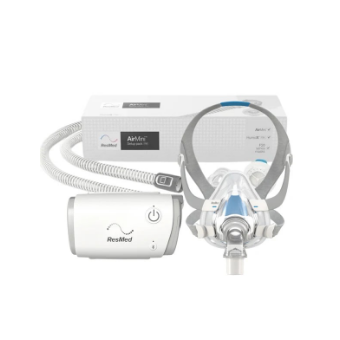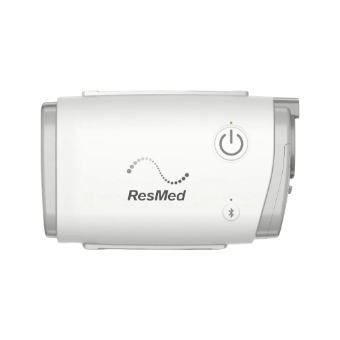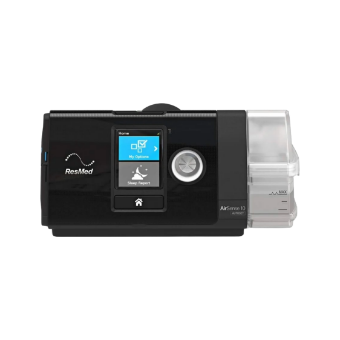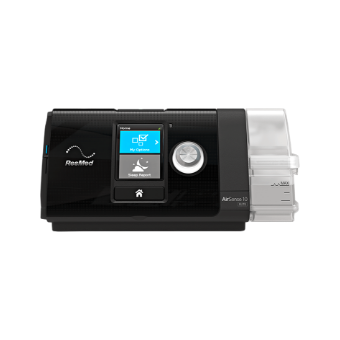Frequently Asked Questions
WHAT IS YOUR QUESTION IN RELATION TO?
- CPAP Therapy
- CPAP Devices
- CPAP Masks
- Cleaning / Maintenance
- Travelling with PAP
- Alternative Therapy
- Diagnostics
CPAP Therapy
-
I am having trouble falling asleep while using CPAP therapy, what can I do to help?
Practice makes perfect! To help get used to wearing the mask during sleep, practice by wearing it during the day while sitting in a chair watching television or reading. This will distract your focus from the mask to a positive, familiar activity. CPAP use will become a habit and part of your routine.
-
Why am I still snoring with CPAP therapy?
Snoring, choking and gasping are eliminated during successful CPAP treatment. If this is not the case you may not be adequately treated. Please call your Sleep Therapy Consultant to help find a solution.
-
My eyes are swollen or irritated. What can I do?
This may be caused by air from your CPAP blowing into your eyes. No air should be directed up into the eye area with a properly sized and fitted mask. This may indicate a mask leak. Make sure the headgear is low and firm at the nape of the neck. The lower straps should sit low and firm. If these straps sit too high, they can pull the mask upwards on your face. If required, gently tighten the lower mask straps taking care not to over tighten. It may also be necessary to tighten the upper straps. Again, take care not to over tighten. Please call your Sleep Therapy Sleep Therapy Consultant to help you correctly fit your mask if these steps do not resolve this issue.
-
There is water in the tubing and sometimes it drips into my mask. How can I stop this?
Excess condensation can form in the CPAP tubing when the temperature of your bedroom is cooler than the air coming from your device. This is what is referred to as ‘rainout’ and does not usually occur when the humidity is set to automatic. This setting can be checked and changed if necessary in your device’s patient menu. If the problem persists the humidifier temperature may need to be adjusted. Please contact your Sleep Therapy Consultant for assistance. The problem can also be rectified by slightly incresing the room temperature until the ‘rainout’ no longer occurs.
-
How can I prevent a dry mouth, dry throat, runny nose, stuffy nose, sneezing after using CPAP?
Allowing a week with the device set to automatic temperature settings may be all that is needed to let your body adjust. Oral or nasal dryness is not usually a long term problem with CPAP therapy. To cope with the initial mouth dryness a mouth gel such as Biotene may be helpful while a nasal spray such as Nozoil may be helpful to reduce nasal lining dryness. A chin strap may also help relieve this issue as it will ensure the mouth remains closed throughout the night. Call your Sleep Therapy Consultant to discuss solutions.
-
Is CPAP therapy covered by Medicare and what is the cost to me?
Medicare does not subsidise the cost of CPAP devices. Check with your Sleep Physician to see if you qualify for other potential subsidies. It is recommended you check with your private health insurance provider to determine if you are eligible for a claim on any aspect of your CPAP therapy.
-
What is the drop off rate for people using CPAP therapy?
Studies show the compliance rate varies depending on a number of factors. Based on a 2016 systematic review of CPAP therapy adherence over a twenty year period, 34% of 3058 patients were non adherent to CPAP therapy. As the technology and equipment in this area continues to advance, this number is likely to decrease.
-
The results are okay, but I don’t feel any different?
This may be due to a number of reasons but here are a few of the most common. It can be difficult to adjust to CPAP therapy, waking in the night may prompt removal of the mask. Many people take their mask off towards morning, convincing themselves that, without it, they can get some “good sleep.” Unfortunately, sleep apnea is often worsened in the last few hours of the night. Rapid eye movement (REM) sleep occurs in the last third of the night. This stage of sleep is associated with vivid dreams and muscle relaxation, to prevent dream enactment. The muscles of the airway relax and this can worsen sleep apnea. By removing the mask in the night, it will reduce the benefits of the therapy and as a result may not feel any different in the morning. If you have mild sleep apnea, with only 10 events per hour, and that number of apneic events is reduced to 5 events per hour with therapy, you may not experience as much improvement. People may expect instant results from CPAP therapy, but this is rarely the case. If sleep apnea is very severe with significant symptoms prior to treatment, a dramatic improvement may occur. When it is more subtle, it may take longer to notice improvement. If you have only used the therapy for a few days, and especially if you have not been able to use it through the night, more time will be required to experience benefits. It may take several weeks before you notice an improvement. If you are not noticing a benefit from your CPAP treatment, speak with your Sleep Therapy Consultant or Sleep Physician about ways that your therapy may be optimized. 3
-
Can I add essential oils into my humidifier chamber?
No, only water can be used in the humidifier. If you are able to purchase distilled water, this will prolong the life of your chamber. See the User Manual for the F&P SleepStyle page 18 under section Water chamber and chamber seal which recommends the use of distilled water to reduce mineral deposits and stains.5
-
Do I need to use my CPAP device every night?
Unfortunately, CPAP therapy does not cure sleep apnea. All it does is keep the airway open to treat the symptoms. If you stop using CPAP device, your airway will once again repeatedly obstruct during sleep. Sometimes if you lose a lot of weight, you may need less pressure or even be able to do without CPAP therapy. But you should talk about that with your Sleep Physician. Almost as soon as you stop CPAP therapy, your sleep apnea will come back. You should use your CPAP device everytime you sleep, including if you take daytime naps. Some people find this hard, but you should try to use it all night, every night. One or two nights with no CPAP therapy (e.g. if you are on holidays) is not likely to be a big problem to you. Most people with sleep apnea have had it for years before they knew it and during this time they didn’t have any treatment. All your symptoms will likely return very quickly once you stop using your CPAP device. You will snore at night and feel tired during the day and you may need to adjust your lifestyle (e.g. not drive) if you are sleepy or tired during the day.7
-
What is the difference between CPAP therapy and oxygen therapy?
CPAP therapy is one of the most effective ways to treat sleep apnea. The equipment has three basic parts. The first is a machine containing an air pump. The second is a mask that covers the nostrils or nose and sometimes the mouth. The third is a tube which links the mask to the machine. During CPAP therapy, the machine draws in air from the room, filters it then gently pressurises it through the tube into the mask. The air pressure helps prevent obstruction of the airway to maintain regular breathing while asleep.
Oxygen therapy may be prescribed when you have a condition that causes your blood oxygen levels to be too low. Low blood oxygen may make you feel short of breath, tired and confused. Oxygen therapy is most often provided through an oxygen concentator. You may need oxygen therapy if you have one of the following conditions; serious respiratory infection, asthma, cystic fibrosis, COVID-19, pnemonia or heart failure. The concentrator provides >90% oxygen through a face mask or nasal cannula. This system does not require a tight seal of the nasal cannula or mask to the face because oxygen therapy is not reliant on maintaining a constant pressure in order to deliver effective therapy.
-
Why does the pressure feel so strong when I wake up?
Your pressure should be just enough to keep your airways unobstructed for a full night of sleep. When your pressure is too low, you can experience more apnea events than the normal 5 per hour. But, if the pressure is too high you can experience side effects like uncomfortable therapy, problems with your CPAP mask, nasal congestion, and interrupted sleep. If you are just beginning your therapy, you may not be used to the pressure change and therefore wake up when the higher treatment pressure is being applied. This is normal, most people will stop waking when the pressure increases after a few days of treatment. The most common reason for feeling a high pressure in the morning is due to an ineffective mask seal. If the mask is not sealed to the face effectively, the air will leak out and you may experience a higher pressure as a result of the device attempting to adjust to the mask leak. If you are ever concerned that your sleep apnea treatment settings are too high for your condition, please consult your sleep physician before making any changes to the settings.9
-
Is CPAP therapy the only way to treat sleep apnea?
Once a diagnosis of OSA is established, talk with your healthcare professional about the need for treatment and the options available for you. The circumstances often vary from person to person, since the underlying causes may be different.
Note: The treatment options provided below are general in nature and should not be relied upon to address your individual needs. Please consult with your healthcare professional to discuss your specific circumstances.
Weight loss – For anyone who is overweight, losing weight is recommended. While this may not necessarily cure the OSA, it usually improves snoring and OSA, and can help other treatments work more effectively. It also provides general health benefits.Reduce alcohol consumption – Alcohol usually worsens snoring and OSA due to the throat muscles relaxing. For some people drinking alcohol makes their OSA worse. If this is the case for you then less or no alcohol may be a effecive treatment.
Body position during sleep – Snoring and OSA are usually worse when lying on your back. This is because of the effects of gravity on the tongue. Avoiding sleep in this position can improve OSA. In some people it can completely control the problem. This is best achieved by wearing a device that makes it uncomfortable to sleep on your back. Some such devices can be purchased or it can be as simple as sleeping with a tennis ball sewn into a pocket on the back of your pyjamas.
Managing blocked nose – A blocked nose causes mouth breathing, which can lead to snoring and OSA. The blocked nose can be due to different problems, such as allergies, sinus disease, and a deviated septum. Your doctor can assess and provide treatment, depending on the problem. This may involve the use of nasal sprays to relieve congestion. Sometimes surgery is required to correct anatomical problems.
CPAP (Continuous Positive Airways Pressure) therapy – This is generally considered to be the most effective way to treat OSA. It involves the use of a special device during sleep, connected to a nose or face mask via tubing. The device gently increases air pressure in your throat holding it open, thus preventing snoring and OSA.
Oral Devices/ Appliances – These are specially made dental plates that are worn during sleep. They push your lower jaw forwards so that your throat opens up, reducing the risk that it will vibrate (snore) or obstruct. The appliances have various names such as Mandibular Advancement Splints (MAS) or Mandibular Advancement Devices (MAD) or Mandibular Repositioning Appliances (MRA) – Your suitability for this form of treatment is best discussed with your healthcare professional, who can then refer you to a trained dentist.
Surgery – Surgery may help in cases of OSA caused by a discrete blockage of some part of the nose or throat. There are many types of operations depending on where in your nose and/or throat the problem lies. The decision about whether surgery is right for you may require the expert input of an ENT surgeon. The risks and benefits need to be weighed up in each case. In adults, surgery is often the last resort, after other treatments have been tried first. Nasal surgery may be useful to help CPAP treatment by allowing nasal masks once the nasal blockage is repaired. In children with OSA, surgery to remove tonsils and adenoids is quite commonly done and is often very helpful.11
-
I have been experiencing sore or dry nasal passages, what should I do?
Sore or dry nasal passages can be due to different problems, such as inadequate humidity, mask leakage, allergies, sinus disease or a deviated septum to name a few. A common solution for airways drying or a stuffy or runny nose is with a humidifier which fits onto the CPAP device. The humidifier is filled with water. When the CPAP device operates, the water heats up and warms and moistens the air that is fed to your airways. Some people may find the use of a humidifier helpful only during cold weather. Others may find it beneficial every night. If sore and dry nasal passages persists, you should consult your healthcare professional to assess your specific situation and recommend suitable treatment options.13
-
How often will i need to replace my mask?
Your mask is arguably the most important piece of equipment in your CPAP setup. Like other regularly used personal health products, such as a toothbrush or razor/shaver, your mask becomes less effective and more unhygienic over time. The best way to know when it’s time for your mask (or any of its parts) to be replaced is to make it a habit of regularly inspecting it for wear and tear. Some mask parts will wear out sooner than you think! Mask cushions, for instance, rest against your face every night and can build up quickly with dirt, oil and bacteria. Without proper care, they can deteriorate leading to leaks and discomfort – even skin irritation. How often you replace your mask cushion depends on the kind you have. Silicone cushions are designed to be replaced every 6 months, whereas memory foam cushions are designed to be replaced monthly. Mask frames are more durable than mask cushions and their lifespan will depend on well you look after them. If they ever get damaged, cracked or discoloured, you should look to replace them. Mask headgear will lose elasticity and stretch out over time, leading to a bad mask fit. A common sign that your headgear needs to be replaced is when you’re starting to overtighten your headgear to achieve a secure seal. We suggest you replace headgear every 8 months or so to ensure your mask is always sealing as secure as it can without the need to overtighten it. Refer to your mask user instructions for further information.15
-
How come Medicare covers the home based sleep study but not for the CPAP therapy?
Medicare provides a rebate for home based sleep studies (HBSS) if the patient is shown to be moderite-high risk based on their answers to the screening questionnaires. We recommended you speak with your doctor to check if you are eligible to have your CPAP device covered by Medicare. Please note that public funding of CPAP equipment differs between states, with each state also having different criteria for funding eligibility.
-
Can I use different manufacturer masks with my CPAP device?
Where possible, it is recommended you use a mask that is from the same brand as your CPAP device. In most cases though, most masks are interchangeable between devices. It is recommenmded you check your CPAP device user manual for more information as in some circumstances there may be compatability issues (e.g. travel CPAP devices).
-
How do I know if I am a mouth breather?
People who breathe through their mouth at night may have the following symptoms: snoring, dry mouth, bad breath (halitosis), hoarseness, waking up tired and, irritable, chronic fatigue, brain fog or dark circles under the eyes.17
-
How much is the therapy equipment?
The cost of CPAP therapy equipment varies depending on what brand and model you are looking at. It’s best to speak to your Sleep Therapy Consultant to find out more about our CPAP package offers and which one is most suitable for you. We also offer CPAP device rentals and interest free plans if you have difficulties in meeting the up front costs.
-
Will my private health insurance cover my sleep study or CPAP device?
This is specific to your own level of cover, we recommend you check with your private health fund directly. If you have extras cover, your private health insurance provider may pay a rebate towards the cost of your CPAP device. The rebate amount may vary between funds and also may depend on your level of extras cover. Some private health insurance funds may also cover part of the cost of the mask. Some private health insurance funds may require a letter of recommendation from your doctor. For those that provide a rebate, an eligible tax invoice will be required.19
-
Is the CPAP device loud?
Treatment should not be louder than a whisper. The noise of the device may fluctuate between inhalation and exhalation, but should mimic that of a soft breathing sound. If your equipment is making loud noises, some of the parts might not be connected properly or it may need to be repaired. If you are hearing a hissing noise, check that all your equipment is connected properly and that there are no holes or deformities.23
You can try placing a mouse pad under the device to reduce noise vibrations. The Philips Beside Organiser offers a noise reducing pad to sit your device on and has a pocket for safe daily storage of mask and tubing as well. Click Here For more info on Philips Bedside Organiser 24
DreamStation – User Manual
AirSense 10 – AutoSet – Clinical Guide
SleepStyle – User Manual
BMC- User Manual
-
How much is it to rent a CPAP device?
We have different rental options to suit your needs. Speak to your Sleep Therapy Consultant to find out about our 1 month, 6 month and 18 month rental programs.
-
How many hours per night should CPAP therapy be used?
The CPAP device needs to be used througout the entire night while you are asleep. Almost as soon as you stop CPAP your sleep apnoea will come back. You should use your CPAP whenever you sleep, including if you take daytime naps. Some people find this hard, but you should try to use it all night, every night. Remember that if you don’t use it, it does not work.27
-
How long will I stay on the Therapy Partnership Program?
There is no set timeframe for your Therapy Partnership Program Introduction. Some patients adjust to CPAP therapy quite quickly and purchase their own device after 2 weeks while others can take up to 4-6 weeks.
-
How do I know what mask is best?
There are variations in each size and style of mask, but the main differences are concerned with the areas of the face are they cover. A nasal pillows mask rests at the entrance of the nostrils, a nasal mask covers the nose and a full face mask covers the nose and mouth. The mask type that best suits you depends greatly on personal needs and preferences. Some things that you may want to take into consideration when deciding what mask type is right for you is your facial anatomy, degree of facial hair, whether or not you’re claustrophobic, and if you have any sinus or nasal issues. Each mask has its own benefits and we recommend you see your Sleep Therapy Consultant or Sleep Physician if you are unsure.29
CPAP Devices
-
It feels like I’m being inflated by my CPAP device, the air is causing me to belch. How can I stop this?
This is known as aerophagia and is caused by swallowing air. This usually subsides once you become more comfortable with breathing against your therapy pressure. Contact your Sleep Therapy Consultant if these problems persist.
-
Which is the best CPAP brand/device?
We carry four brands; Philips, ResMed, Fisher & Paykel and BMC. All four brands have various models with slightly different features. Speak to your Sleep Therapy Consultant or Sleep Physician to find out which one is best suited for you.
-
How long will my CPAP device last?
The life expectancy of a CPAP device differs based on the specific model, its usage, its operating environment and how well it is maintained. In general, CPAP devices have a service life of approximately three to five years.
-
Can I travel with my CPAP device?
You should certainly try to use your CPAP device while on holidays. It will help you and those you travel with enjoy the holiday more. Most CPAP devices work on both 110 and 240 volts power sources. Many CPAP devices also run on a 12 volt battery. This means they can be used when overseas and while camping. As a general rule, most CPAP devices are able to run on other voltages, such as 110V in the United States without modification, as they have an inbuilt “switch mode” power supply.3
If you plan to use your device while on a flight, ResMed Airsense 10, ResMed AirMini,4 and F&P SleepStyle all automatically compensate for the change in altitude.5 Philips Dreamstation, Philips Dreamstation Go 6and F&P SleepStyle all automatically compensate for the change in altitude.
-
Can I leave my CPAP device switched on at the power point?
Yes, the CPAP device will only start therapy when you press the start button on the device or if the mask is applied to your face (only if the Auto Start setting is switched on). When the Auto Start setting is on, the CPAP device will detect your breathing through the mask and begin therapy. Otherwise the device will remain in sleep mode.
-
Is the device noisy?
Treatment should not be louder than a whisper. The noise of the device may fluctuate between inhalation and exhalation, but should mimic that of a soft breathing sound. If your equipment is making loud noises, some of the parts might not be connected properly or it may need to be repaired. If you are hearing a hissing noise, check that all your equipment is connected properly and that there are no holes or deformities.11 You can try placing a mouse pad under the device to reduce noise vibrations. The Philips Beside Organiser offers a noise reducing pad to sit your device on and has a pocket for safe daily storage of mask and tubing as well.
BMC G3 A20 F&P SleepStyle Auto Resmed AirSense10 Philips DreamstationSound Pressure Level < 28 dBA (at 10cmH2O) <28 +/- 1.5 dBA (at 10cmH2O) <27 +/- 2 dBA (at 10cmH2O) <27 +/- 2 dBA (at 10cmH2O)Power Noise Level < 36 dBA <35 dBA <35 +/- 2dBA <35 +/- 2dBA Airsense 10: Autoset – Clinical Guide
DreamStation: User Guide
Sleep Style: User Manual
BMC: User Manual
-
Are CPAP and APAP both effective?
CPAP devices deliver a constant air pressure while the patient is sleeping. Automatic, or Auto-Titrating Positive Airway Pressure (APAP) devices use an algorithm to deliver a variable air pressure according to the patient’s needs. By constantly measuring how much resistance is present in your breathing on a breath-by-breath level, APAP technology knows whether to decrease pressure when the upper airway is stable, and increase pressure when it senses an airway event (such as an apnea, a hypopnea, flow limitation or snoring). Both CPAP and APAP are effective treatments of sleep apnea but unlike CPAP devices, APAP devices only deliver the amount of pressure necessary at any given moment. This can contribute to a more comfortable therapy experience for the patient. Some Physicians find patients with more complex sleep apnea conditions (such as REM-related apnea or positional apnea), or who simply cannot get used to standard CPAP therapy, may experience better results with APAP therapy.
-
How is the CPAP device serviced?
We encourage you to have your CPAP, APAP or BiLevel sleep apnea device pressure tested to ensure you are still receiving the correct pressure. Utilising a pressure manometer, we test the device to ensure it reaches and maintains the pressure that is set. Depending on the results of the general servicing, it may have to be sent to the manufacturer for further assessment.
-
How do I travel with my CPAP device in aeroplanes?
Before flying with your sleep therapy equipment, you should: Get clearance from the airline to use your device on the flight at least two weeks prior to the date of departure. If your approval is in the form of a letter, carry a copy with you when checking into your flight. Find out if you can sit near a power source on the aircraft. If you don’t have access to power, the RPS II, our lightweight and portable external battery, is designed to run an AirSense™ 10, AirCurve™ 10 or Lumis™ sleep apnea device (without humidification) for over 14 hours. Operating time is reduced with older batteries. See the Battery/device compatibility list for details of operating times with other ResMed devices. Confirm the type of power cord or adapter used by the aircraft. Carry a letter from your doctor certifying your need your CPAP device for sleep apnea therapy. Take a copy of ResMed’s FAA compliance letter for ResMed sleep apnea devices.
Ensure that there is no water in the humidifier tub before detaching it from the CPAP device and pack it away. Do not use your humidifier on the aircraft as turbulence increases the risk of water spillage and damage to the device. Enable Airplane Mode (in devices with wireless connectivity*. See user manual for details.) Most ResMed sleep apnea devices run on most aircraft power supplies with a suitable adapter. While most of our CPAP devices will automatically compensate for altitude changes experienced during the flight. Some older CPAP devices might require manual adjustment. If no adjustment is made, it may deliver less effective therapy. Please consult your doctor for more information.
-
How much is the therapy equipment?
The cost of CPAP therapy equipment varies depending on what brand and model you are looking at. It’s best to speak to your Sleep Therapy Consultant to find out more about our CPAP package offers and which one is most suitable for you. We also offer CPAP device rentals and interest free plans if you have difficulties in meeting the up front costs.
-
How come I need the humidifier?
The air delivered during therapy may overwhelm the body’s ability to add heat and moisture, which can lead to a sore, dry throat, nasal congestion, or a runny nose.19Heated humidification has been shown to help minimise the side effects associated with positive airway pressure therapy, and help make it a more comfortable experience.
-
Do you have to use the humidifier?
No, you do not have to use the humidifier, but it is recommended because it adds heat and moisture to the dry air that is being provided with the therapy.
-
How will I know if I should stay on CPAP treatment?
You should first determine if CPAP treatment is effective at treating your sleep apnea. If your apnea hypopnea index (number of times you stop breathing per hour) has been reduced while on therapy, then this is a good indication that the therapy is effective in treating your condition. You should also consider if the symptoms associated with sleep apnea are resolving as a result of the therapy. You should consult your physician if you have any concerns about continuing your CPAP treatment.
-
Do I have to change the water in my humidifier every day?
Yes. Humidifiers are a potential source of Legionnaires’ disease. Patient education on device maintenance is important in reducing the risk of infection. Proper upkeep of your CPAP device can help ensure the device functions properly. We recommend using fresh distilled water in your humidifier before starting your therapy. Distilled water prevents mineralization in the humidifier, and helps extend its operating life
-
How do I know if my therapy pressure is accurate?
If your Apnea Hypnopnea Index or AHI (number of times you stop breathing per hour) is considered controlled in comparison to your AHI on your sleep report, your device pressure is generally considered accurate. If you use an Auto-titraing device, the mask seal, body position and allergies are just a few factors that can contribute to changes in your pressure during therapy. You should consult your physician if you have any concerns about the pressure setting of your CPAP device and its impact on the effectveness of your CPAP treatment.
-
Can I change the settings on the CPAP device myself?
We advise that you speak to your Sleep Physician if you would like change the settings on your device relating to your prescription. Depending on the change, you may require another prescription from your Sleep Physician. Your Sleep Therapy Consultant may be able to make small adjustments to the device’s comfort, humidity and temperature settings. This may be done remotely if you are registered with our connected care system.
-
Why am I still tired after using my CPAP device?
This may be due to a number of reasons. A few of the most common ones are described here.
1. Removal of Mask: It can be difficult to adjust to CPAP therapy, waking in the night may prompt removal of the mask. Many people take their mask off towards morning, convincing themselves that, without it, they can get some “good sleep”. Unfortunately, obstructive sleep apnea is often worsened in the last few hours of the night. Rapid eye movement (REM) sleep occurs in the last third of the night. By removing the mask at any stage during the night, you reduce the benefits of the therapy and as a result may not feel any different in the morning.
2. Mild Sleep Apnea: If you have been diagnosed with mild sleep apnea, with only 10 events per hour, and the number of apneic events is reduced to 5 events per hour with therapy, you may not experience as much improvement.
3. Not Enough Time: People may expect instant results from CPAP therapy, but this is rarely the case. If sleep apnea is very severe with significant symptoms prior to treatment, a dramatic improvement may occur. When it is more subtle, it may take longer to notice improvement. If you have only used the therapy for a few days, and especially if you have not been able to use it through the night, more time is required to experience improvements. It may take several weeks before you can note the improvement. If you are not noticing a benefit with your treatment, speak with your Sleep Therapy Consultant about ways to optimize your therapy. If this persists, see your Sleep Physician.
-
Can I set an alarm on the device to wake me to put my mask back on?
Your mask needs to be fitted throughout the night in order to achieve the full benefits of your therapy. If you are removing the mask off during the night consciously or unconsciously, it is a good indication that either your mask is not fitted correctly or you may need replace a mask part. Most patients unknowingly remove their mask because it’s uncomfortable or leaking.
-
Why does my humidifier use different amounts of water each night?
Most humidifiers have manual and automatic settings. Manual settings are set by the user, while automatic settings allow your humidifier to make adjustments to maintain a certain temperature and humidity level throughout the night. The temperature and humidity of the room where you are sleeping will have an effect on the amount of water used in the humidifier. For example, if your environment is quite hot and humid, the humidification device is more likely to deliver less humidity and thus result in more water remaining in the water chamber at the end of your therapy. If you have a large mask leak, this may also increase the amount of water used by the device. If you are having difficulties with the settings on your humidifier, refer to the user manual or consult your Sleep Therapy Consultant for support.
-
How much weight will I lose after starting CPAP therapy?
Untreated sleep apnea can reduce time spent in calorie-burning activities. Feeling low energy, tired, and unfocused are common sleep apnea symptoms that make it hard to participate in daily activities such as walking the dog, mowing the lawn or pushing a shopping cart. If diagnosed with OSA, CPAP therapy can improve your sleep and overall well-being.29A healthier lifestyle will have a positive impact on your weight loss efforts. By improving your sleep quality, CPAP therapy can lead to significant weight loss in the first 3 months of therapy in obese people with severe sleep apnea.
-
Fisher & Paykel
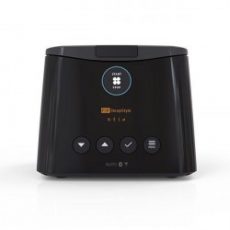
Fisher & Paykel SleepStyle Auto
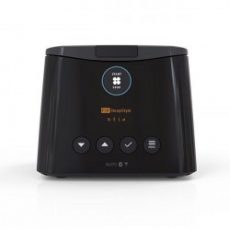
Fisher & Paykel SleepStyle
-
Philips
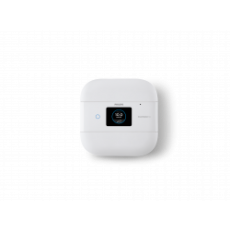
Philips DreamStation Go
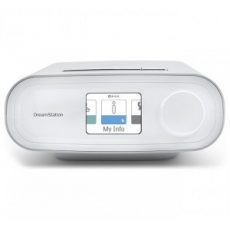
Philips DreamStation PAP/APAP
-
ResMed
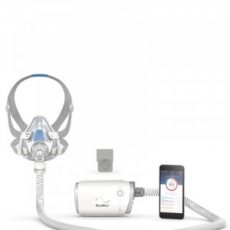
ResMed AirMini Bedside Starter Kit
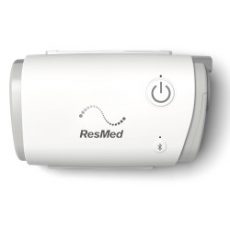
RESMED AIRMINI
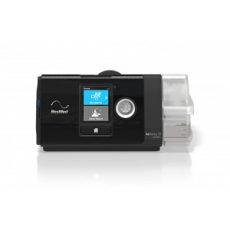
RESMED AIRSENSE 10 AUTOSET 4G
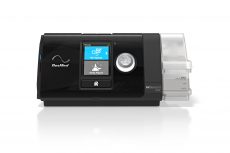
AirSense 10 Elite
-
BMC
CPAP Mask
-
The air pressure in my mask seems too high, it feels like I am getting too much air. Can I change this?
Make sure your mask is fitted correctly. Use a mirror to make sure the mask is symmetrically secured on your face. You can run a Mask Fit Test for confirmation by selecting this menu option on your CPAP device. Be aware, the pressure used during the test is often higher than what you will experience during your therapy. Refer to each device’s troubleshooting section for how to run the Mask Fit Test or ask your Sleep Therapy Consultant for more information.
-
How do I prevent irritation, pressure sores or bruises from my mask?
If irritation or sores are developing, chances are you are over tightening your mask or your mask cushion and/ or headgear are due to be replaced. If this is not the cause then the shape of the mask may not suit you and a different mask choice may provide a more comfortable fit. Please contact your Sleep Therapy Consultant to help you refit your mask or provide an alternate solution.
-
My bed partner is bothered by the airflow from my mask. How can I reduce the air escaping from my mask?
All masks have exhalation ports to allow the escape of exhaled air which contains carbon dioxide. The higher the device pressure setting, the stronger this escape flow will be. Do not cover these exhalation ports as they are vital to the expulsion of carbon dioxide. Masks vary in their air diffusion features, if the escape flow is too much for you or your bed partner please contact your Sleep Therapy Consultant to try another mask.
-
My mask keeps coming off during sleep. What do I do?
Your mask size, style or fit may not be appropriate. Call your Sleep Therapy Consultant to discuss fit tips.
-
How long will it take me to get used to my mask?
Wearing a CPAP mask can seem intimidating at first, however the key to adjusting to CPAP therapy is consistency. By wearing your mask and using the CPAP device every night, you are more likely to adjust quickly. Wearing your mask while reading or watching TV during the day or before bed may assist in acclimatising to CPAP therapy.1
-
There is water in the tubing and sometimes it drips into my mask. How can I stop this?
Excess condensation can form in the CPAP tubing when the temperature of your bedroom is cooler than the air coming from your device. This is what is referred to as ‘rainout’ and does not usually occur when the humidity is set to automatic. This setting can be checked and changed if necessary in your device’s patient menu. If the problem persists the humidifier temperature may need to be adjusted. Please contact your Sleep Therapy Consultant for assistance. The problem can also be rectified by slightly incresing the room temperature until the ‘rainout’ no longer occurs.
-
Can I lay down on my side with the mask?
Some masks are more suitable for certain sleeping positions, but in gerenal, all masks are designed to accomodate any sleeping position. The exhalation ports on the mask allow exhaled breath to escape the mask no mater what position you are laying in.
-
Why does air come out of the exhalation ports?
The exhalation ports on your CPAP mask allow for exhaled breath to be vented out of the mask.
-
Can I buy parts of the mask separately (e.g. headgear, cushion)?
Yes, all of the mask parts can be purchased separately.
-
Why do I have to keep my mouth closed?
If your mouth is open while using a nasal pillow or nasal mask, air may leak out of your mouth instead of travelling into your upper airway. Most CPAP devices can accomodate for a small leakage but if the leak is too high, your CPAP device may provide more pressure than what is actually required to maintain an open airway. Chin straps are useful in maintaining a closed mouth.3
-
What’s the difference between a nasal pillow mask, a nasal mask and a full face mask?
The variation in mask size is one difference, but the main difference is the area of your face that the mask covers. A nasal pillow mask rests at the entrance of your nostrils, a nasal mask covers the nose and a full face mask covers the nose and mouth. The mask type that best suits you depends greatly on personal needs and preferences. Some things that you may want to take into consideration are your facial anatomy, facial hair, whether or not you’re claustrophobic, and if you have any underlying sinus or nasal conditions. Each mask has its own benefits and it’s recommend you see your Sleep Therapy Consultant or Sleep Physician if you are unsure on what will be best suited to your situation.5
-
Why does it leak air?
If the mask is not fitted to the face properly, it will not provide a effective seal and the air will leak out. If this is experienced, try readjusting the mask straps to ensure you have a tight seal to your face.7
-
How often do I need to replace parts?
Your mask is arguably the most important piece of equipment in your CPAP setup. Like other regularly used personal health products, such as a toothbrush or razor/shaver, your mask becomes less effective and more unhygienic over time. The best way to know when it’s time for your mask (or any of its parts) to be replaced is to make it a habit of regularly inspecting it for wear and tear. Some mask parts will wear out sooner than you think! Mask cushions, for instance, rest against your face every night and can build up quickly with dirt, oil and bacteria. Without proper care, they can deteriorate leading to leaks and discomfort – even skin irritation. How often you replace your mask cushion depends on the kind you have. Silicone cushions are designed to be replaced every 6 months, whereas memory foam cushions are designed to be replaced monthly. Mask frames are more durable than mask cushions and their lifespan will depend on well you look after them. If they ever get damaged, cracked or discoloured, you should look to replace them. Mask headgear will lose elasticity and stretch out over time, leading to a bad mask fit. A common sign that your headgear needs to be replaced is when you’re starting to overtighten your headgear to achieve a secure seal. We suggest you replace headgear every 8 months or so to ensure your mask is always sealing as secure as it can without the need to overtighten it. Refer to your mask user instructions for further information.9
-
Can I use a cannula instead of a mask?
No. A nasal cannula is too small and will not create a seal against your nostrils. The leak around the nasal cannula would be too high and the CPAP device would not be able to deliver the desired air pressure required to keep your airway open.
-
What part of the mask needs to cleaned more frequently?
Click here to see our recommended cleaning schedule.
-
How much will the mask cost?
The cost of the mask varies depending on what brand and model you are looking at. It’s best to speak with your Sleep Therapy Consultant to find out more information about our range of masks.
-
Why can’t I have the tiny pump CPAP I saw online?
To date, micro-CPAP devices are not registered for use in Australia. We only offer CPAP equipment that is registered for use in Australia as part of our therapy service.11
-
Why can’t I use a mouth guard device (e.g. Mandibular Advancement Splint) instead of a CPAP therapy?
You can consider a Mandibular Advancement Splint (MAS) if you have been diagnosed with mild to moderate OSA, or moderate to severe OSA and intolerance to CPAP.13MASs are specially made dental plates that are worn during sleep. They push your lower jaw forwards so that your throat opens up, reducing the risk that it will vibrate (snore) or obstruct. MASs are not suitable for patients with central sleep apnoea or with no teeth or very poor dental structure.14
-
How do I keep my mouth shut with CPAP therapy?
A chinstrap may be helpful to keep your mouth closed and thus reduce mouth leakage. It is usually a piece of fabric, often fitted with velcro, that can be secured around your lower jaw and the top of your head. Speak to one of our Sleep Therapy Consultants about which size is best suited for you.17
-
How do I prevent the silicone mask parts from ripping?
It is important to clean your mask on a weekly basis. Dirt and oil from your skin can stick to the cushion and weaken the silicon (see “What part of the mask needs to cleaned more frequently?”) . Also, be sure to handle the silicone parts with care.
-
How do I know what mask is best for me?
There are variations in each size and style of mask, but the main differences are concerned with the areas of the face are they cover. A nasal pillows mask rests at the entrance of the nostrils, a nasal mask covers the nose and a full face mask covers the nose and mouth. The mask type that best suits you depends greatly on personal needs and preferences. Some things that you may want to take into consideration when deciding what mask type is right for you is your facial anatomy, degree of facial hair, whether or not you’re claustrophobic, and if you have any sinus or nasal issues. Each mask has its own benefits and we recommend you see your Sleep Therapy Consultant or Sleep Physician if you are unsure.19
-
Which mask best suits someone with a beard?
If you comfortably breathe through your nose at night, a nasal pillow mask is a good option if you have a beard, as it sits underneath the nose and forms a seal inside the nostrils. Facial hair is unlikely to interfere with the use of this type of mask.
-
Fisher & Paykel

Fisher & Paykel SleepStyle Auto

Fisher & Paykel SleepStyle
-
Philips

Philips DreamStation Go

Philips DreamStation PAP/APAP
-
ResMed

ResMed AirMini Bedside Starter Kit

RESMED AIRMINI

RESMED AIRSENSE 10 AUTOSET 4G

AirSense 10 Elite
-
BMC
Cleaning / Maintenance
-
Are all the parts waterproof (e.g. heated tube and mask straps)?
The tubing is waterproof. It’s made up of corrugated plastic that is highly flexible and durable. Most masks consist of hard plastic and soft silicon, all of which are waterproof. The headgear attached to the mask is made up of a soft fabric which is not waterproof.
-
How do I clean my mask?
It is recommended that you wash your mask in clean warm (around 30°C) water with mild liquid detergent, making sure you rinse all components thoroughly before allowing them to dry naturally (i.e. air or drip dry). Make sure you do not soak the mask. If you’re running short of time our mask wipes are a fast and easy cleaning option that can be used on any mask. Simply wipe out the mask and leave to dry naturally. Avoid soap with conditioners or moisturisers. Do not use bleach, alcohol, or cleaning solutions containing alcohol. See our printable cleaning guideline here. For more specific instructions on cleaning your mask, please refer to your mask user guide.
-
How do I clean my humidifier chamber?
After each use, we recommend that your humidifier chamber is washed out with a mild detergent and warm water. Once a week we recommend your humidifier chamber is soaked in 1 part vinegar and 5 parts warm water for 30 mins to kill any potential bacteria build up. Rinse thoroughly and allow it to dry away from direct sunlight before your next use. Replace the chamber if it is leaking or has become cracked, cloudy or pitted or the humidifier seal is cracked or torn. See our printable cleaning guideline Click Here to view our CPAP cleaning card. Our cleaning recommendation is a general guide only. Always refer the equipment user manuals for detailed cleaning instructions for your specific equipment as humidifier cleaning methods can differ between equipment manufacturers.
-
Can I use detergent to clean the mask?
Yes, a mild liquid detergent can be used when cleaning your mask. Avoid soap with conditioners or moisturisers. Do not use bleach, alcohol, or cleaning solutions containing alcohol.
-
Can I put oils in my humidifier chamber?
No. Do not add anything other than water to your humidifier chamber (preferably distilled water). Your CPAP device delivers humidity to your airway and lungs, adding oil could cause nasal and lung irritation.
-
How long can I use a filter before I need to change it?
Depending on the CPAP device you are using, we recommend changing your filter every 1 – 6 months depending on usage and the environment the device operates in.12
-
Why do I need to clean some of the equipment everyday?
Patient education on device maintenance is important in reducing the risk of infection. Proper upkeep of your CPAP device can help ensure the device functions properly and proper equipment hygiene is maintained for your safety.5 For example, humidifiers are a potential source of Legionnaires’ disease and other equipment may build up harmful bacteria and mould if not cleaned regularly.6
-
What wipes/soap do I use to clean the mask?
We offer a mask/hose soap and wipes that are specifically designed for this purpose.
Click Here to view our range of CPAP cleaning products.
-
Can you just send me 2 filters every 6 months and bill my credit card?
We don’t currently have this automation set up but it’s something we may consider looking at in the future.
-
How often should I be cleaning my mask?
Click Here to view our cleaning card
-
What type of soap do I need to clean my tubing?
Avoid using soaps containing conditioners or moisturisers. We offer a mask & hose soap that is spefically designed for this purpose.
Click Here to view our range of CPAP cleaning products
-
How often should I have my device checked?
We encourage you to have your CPAP, APAP or bilevel sleep apnea device pressure tested to ensure you are still receiving the correct pressure. Utilising a pressure manometer, we test the device to ensure it reaches and maintains the pressure that is set. Depending on the results of the general servicing, we may have to send it to the manufacturer for further assessment.
-
Do I need to use distilled water or can I use regular tap water in my humidifier?
The safety and quality of your water supply may be the key consideration in deciding whether to use distilled water in the humidifier. Boiling water will kill microbes, but it will not remove minerals or chemical contaminants. These minerals that make water “hard” include calcium, magnesium, iron, and others. If they are present in the water put in the humidifier’s water chamber, over time scale will develop that discolors the container and could damage the device. Filtered water may remove some of the minerals but may not remove living organisms or other chemicals. Bottled water that has been distilled may be an alternative option to regular tap water. The use of distilled water will maximize the life of the water tub by reducing the buildup of mineral deposits. Distilled water is available to buy at many grocery stores9
-
Are the mask, tube and humidifier dishwasher safe?
It is not advisable to clean your equipment in a dishwasher or washing device as it could become damaged. CPAP masks are not dishwasher safe because they cannot withstand the high temperatures and dramatic temperature changes of a dishwasher cycle.11
This can cause the plastic to wear down and break. It is better to clean the mask and the tubing by hand in warm, soapy water. Always refer the equipment user manuals for recommended cleaning instructions for your specific equipment.12
-
What is the white stuff in my humidifier chamber?
This is most likely a build up of calcium deposits as a result of using regular tap water in your humidifier chamber. Follow our cleaning guide to remove the build up of calcium. We recommend using fresh distilled water in your humidifier before starting your therapy. Distilled water prevents mineralisation in the humidifier and helps extend its operating life.
What to do daily, weekly, monthly and yearly
-
Mask
-
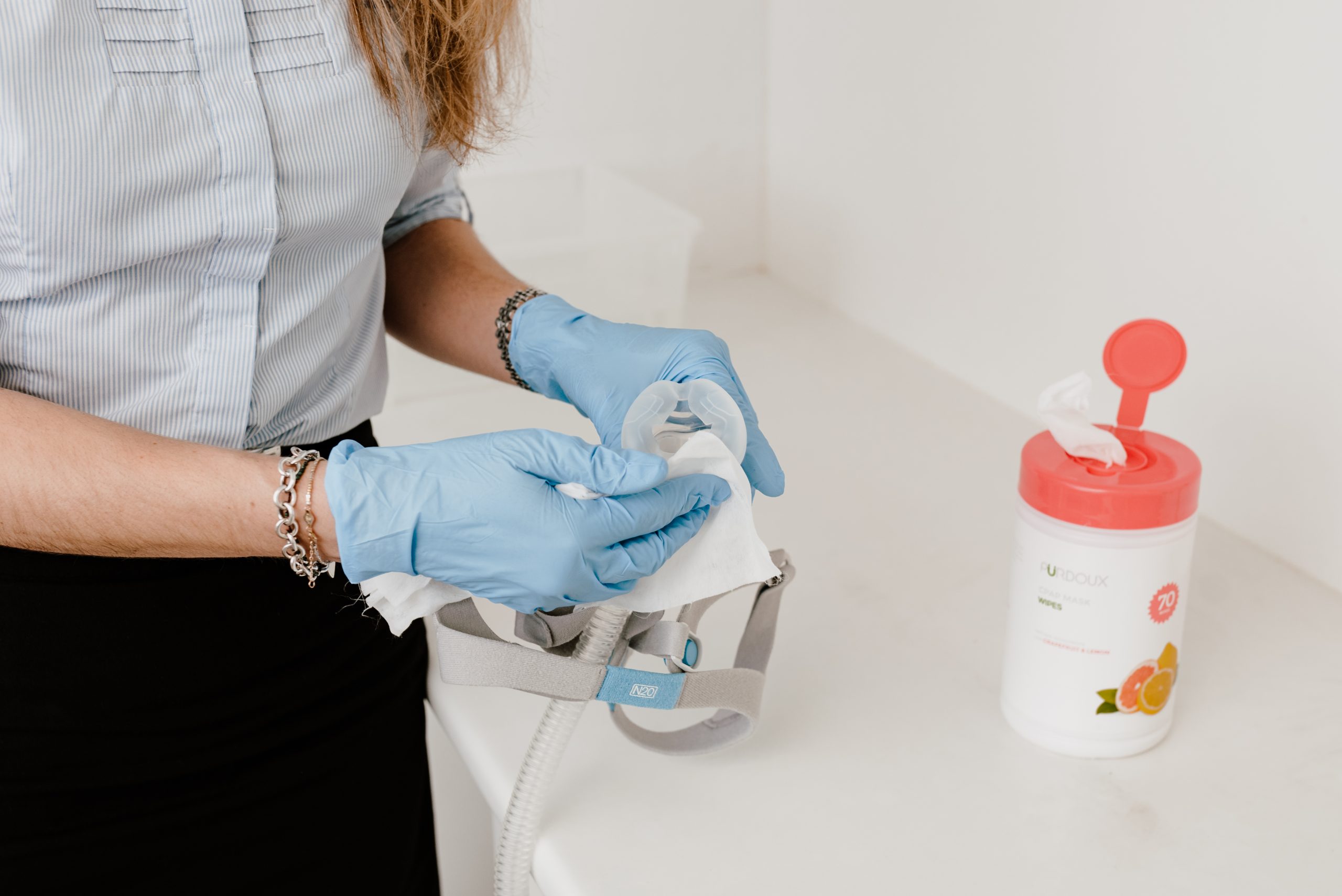
Daily
- Wipe Cushion with CPAP MASK WIPES (warm soapy water can also be used)
- Air dry during the day (Avoid direct sunlight)
-
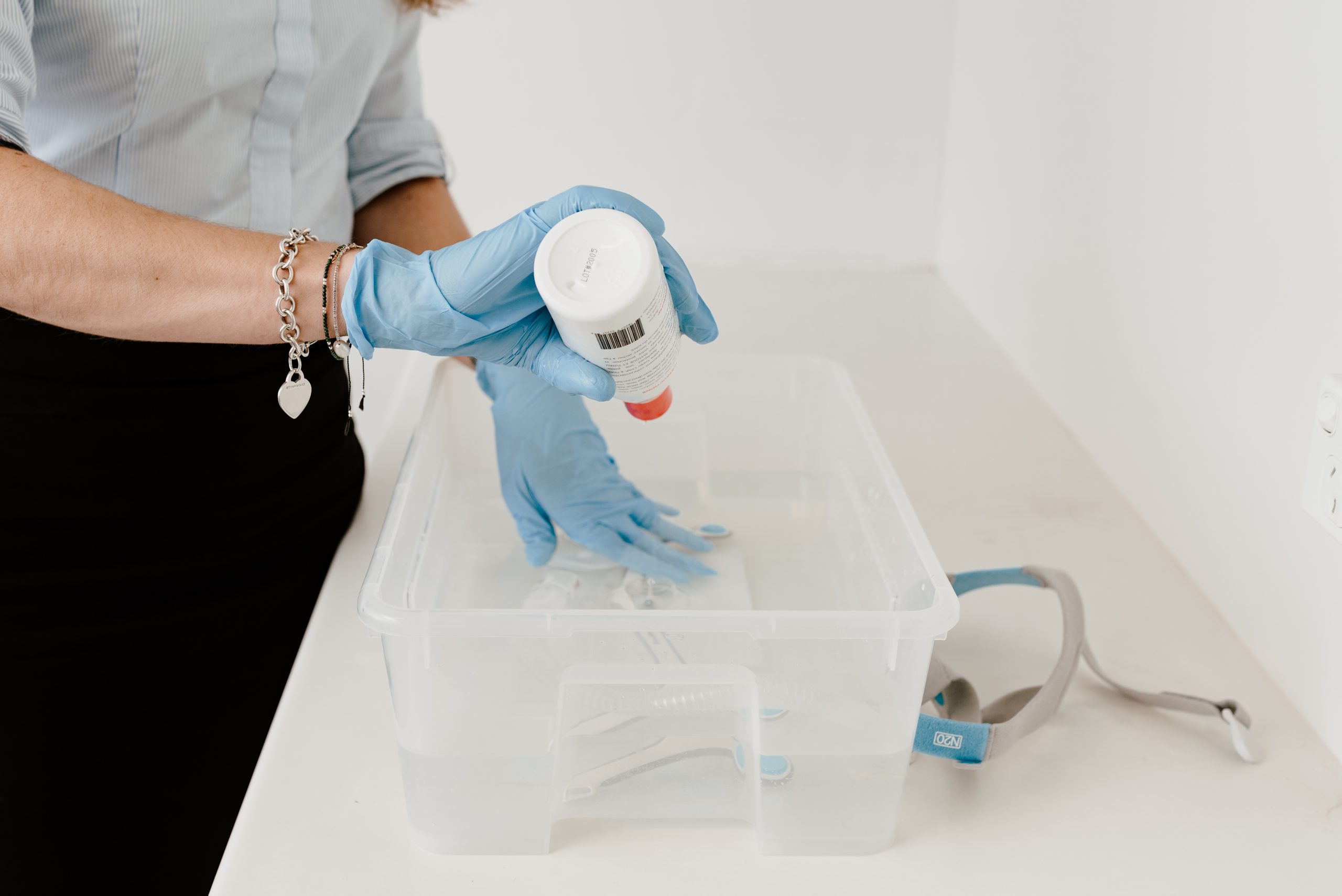
Weekly
- Hand wash all parts with Mask & Hose Soap (warm soapy water can also be used)
- Air dry during the day (Avoid direct sunlight)
-
-
Tubing
-
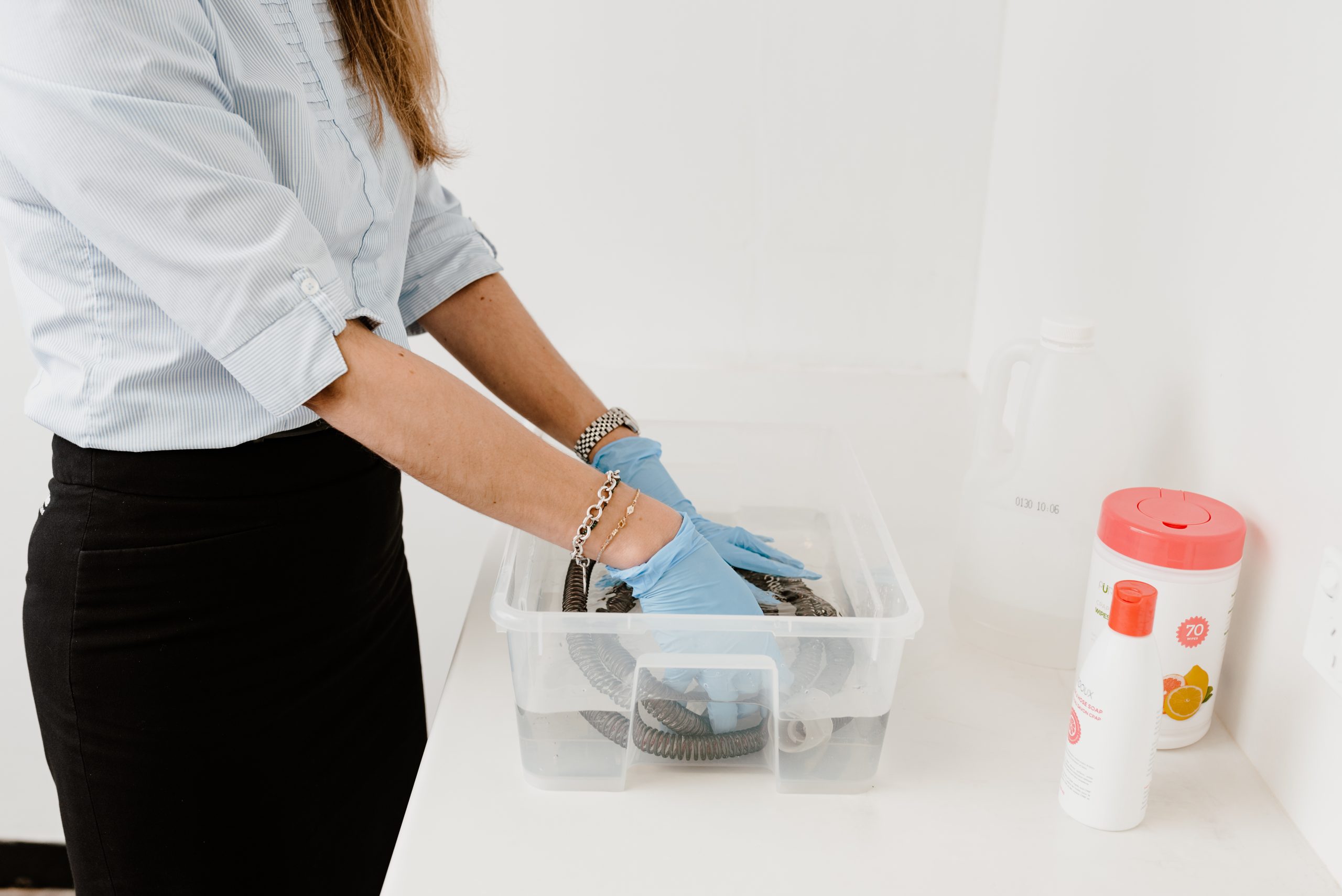
Weekly
- Hand wash all parts with Mask & Hose Soap (warm soapy water can also be used)
- Air dry during the day (Avoid direct sunlight)
-
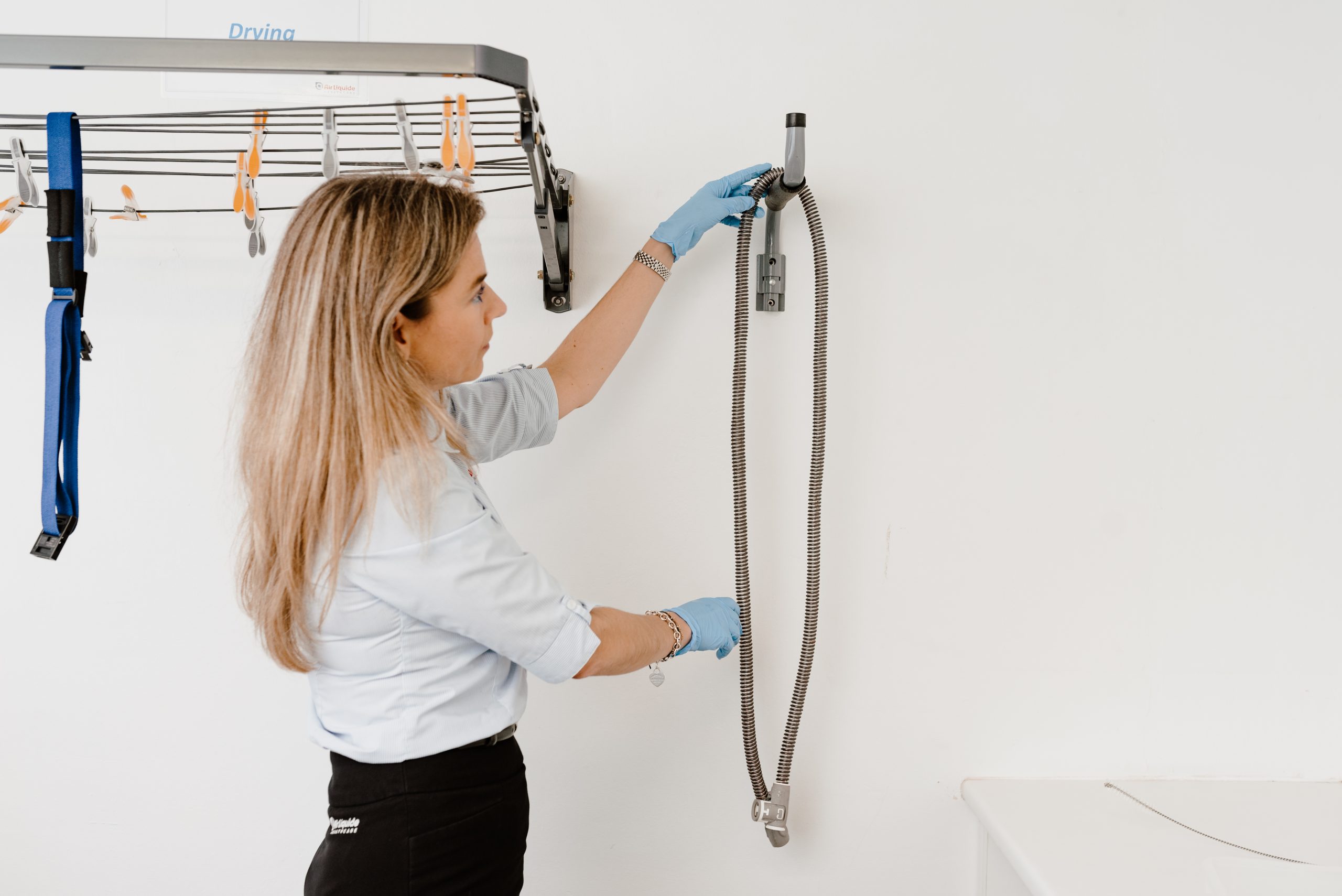
Monthly
- Check for holes and damage
-
-
Humidifier
-
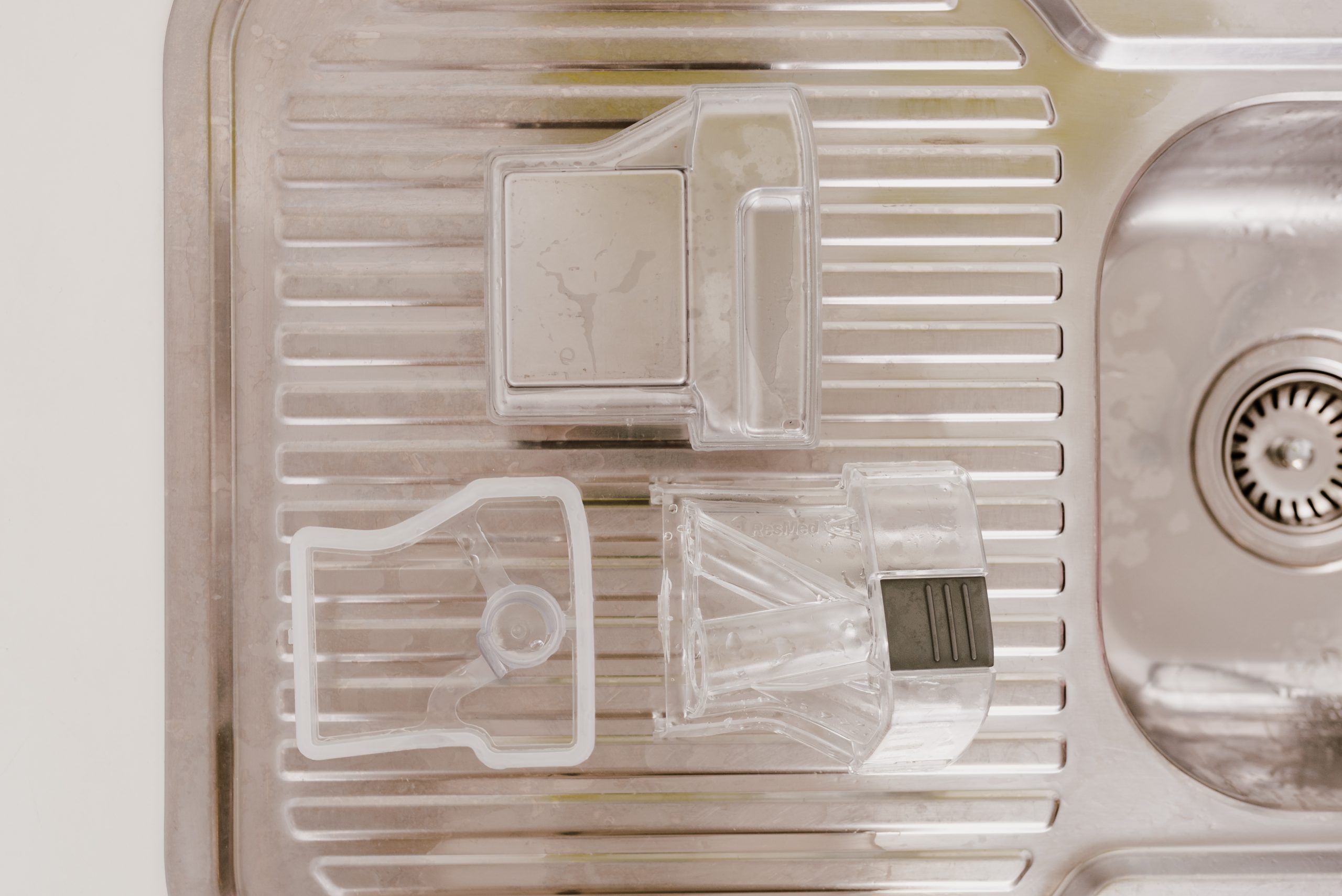
Daily
- Remove humidifier
- Empty remaining water
- Rinse with warm water
- Air dry during day (avoid direct sunlight)
-
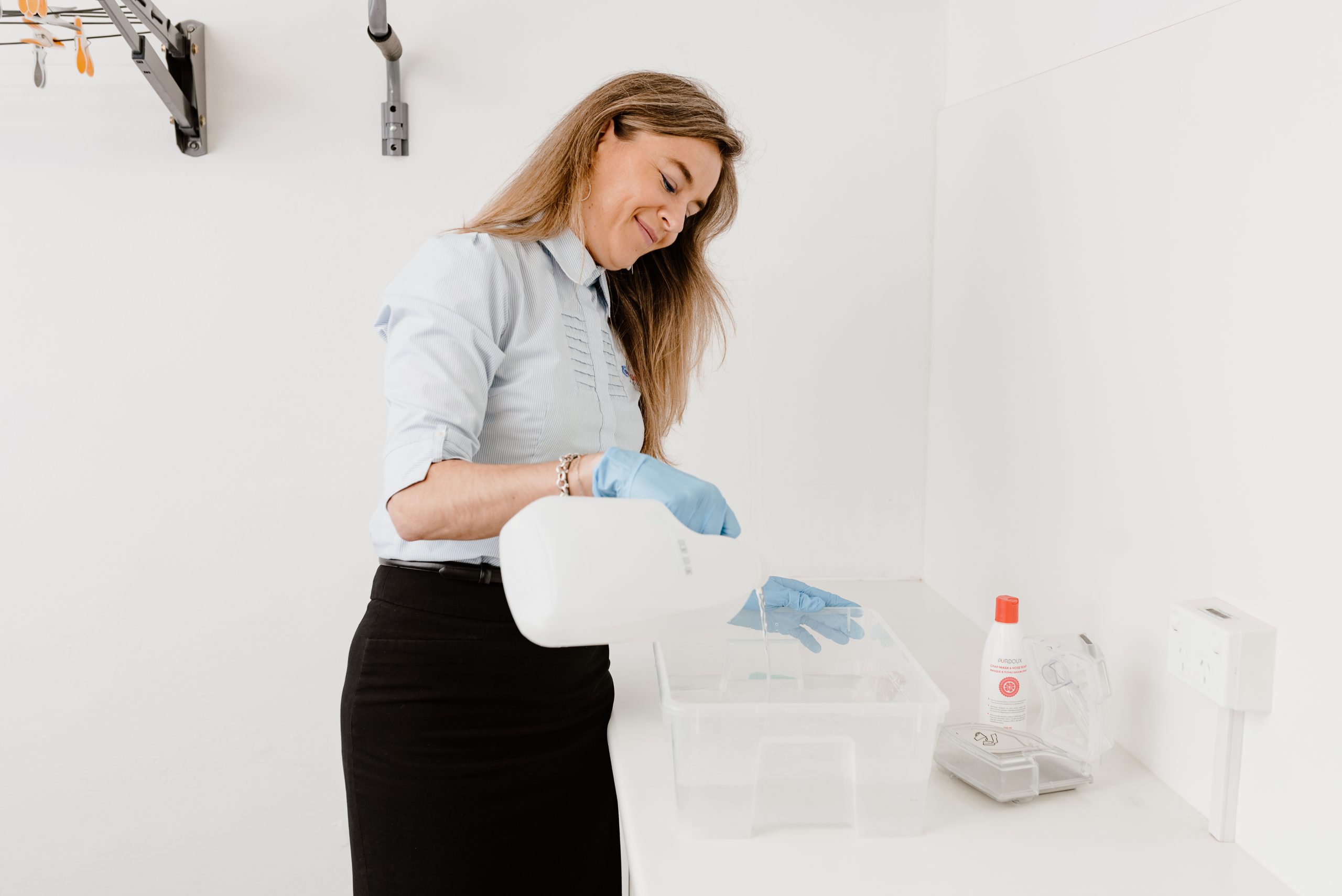
Weekly
- Dismantle humidifier
- Soak 30 mins in 1 part vinegar and 5 parts warm water
- Rinse thoroughly before next use
-
-
Filter
-
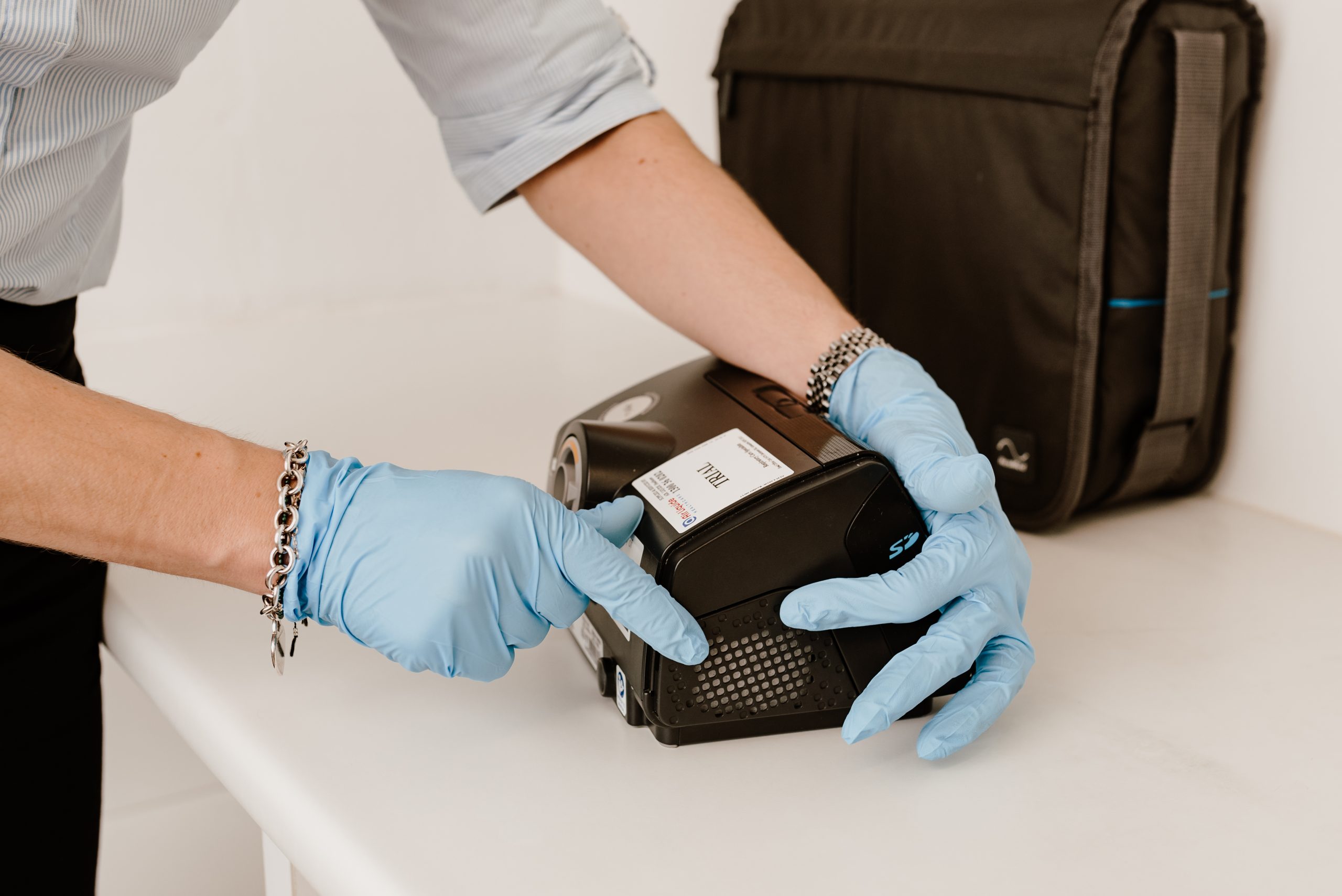
Weekly
- Check for dust build up
- Ensure filter is not rotated when returned to machine (can suck debris into motor)
-
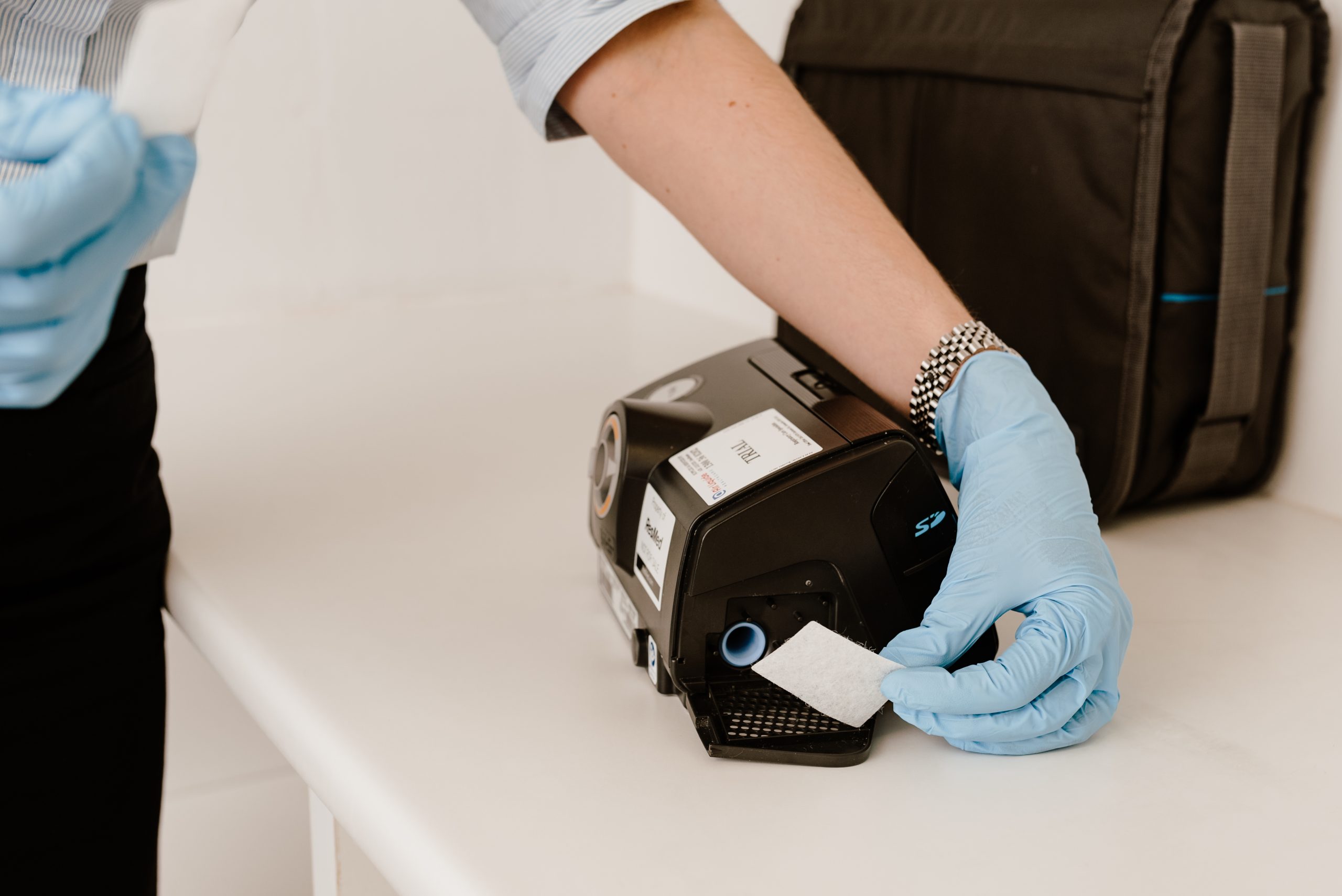
1-6 Months
- Replace filters as needed
-
Step by Step Cleaning Guide
-
Cleaning your CPAP Devices
-

Step 1: Unplug your PAP device from the power source and place on a flat surface. Open the air filter cover.
-

Step 2: Remove air filter and assess cleanliness, if white place back on cover. If discoloured, dispose in bin and replace with new air filter. The air filter is not washable and should be changed every 1-6 months.
-

Step 3: Remove the humidifier chamber, empty remaining water and dismantle parts where possible.
-

Step 4: Fill basin with 1 part vinegar, 5 parts warm water. Soak for 30 mins.
-
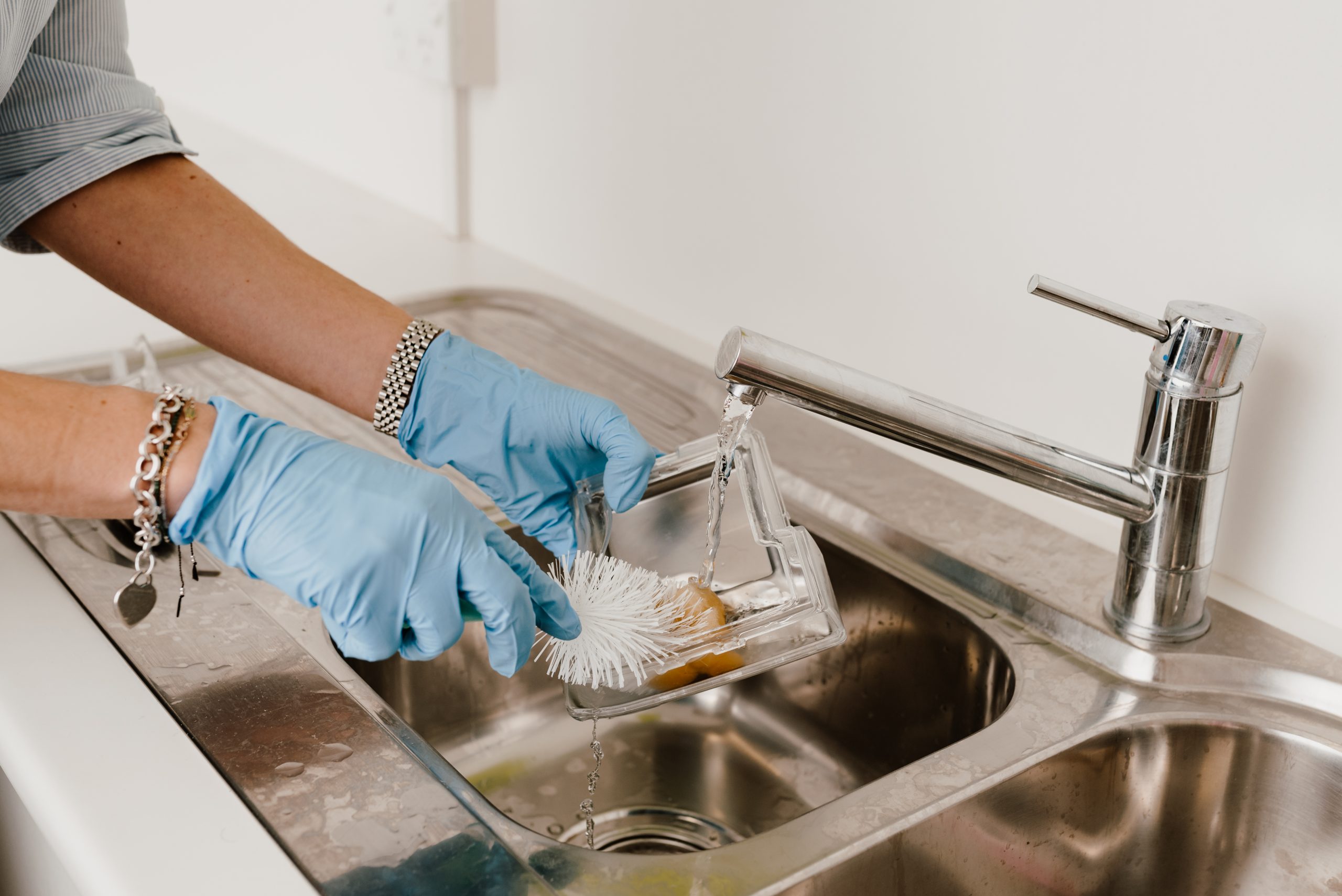
Step 5: Remove humidifier chamber from basin and rinse thoroughly. We find a bottle brush to be an effective cleaning tool.
-

Step 6: Air dry during the day and avoid direct sunlight.
-
-
Cleaning Your CPAP Mask
-

Step 7: Fill basin with warm soapy water. Avoid using strong cleaning products including dish detergents as they may damage the mask or leave harmful residue.
-
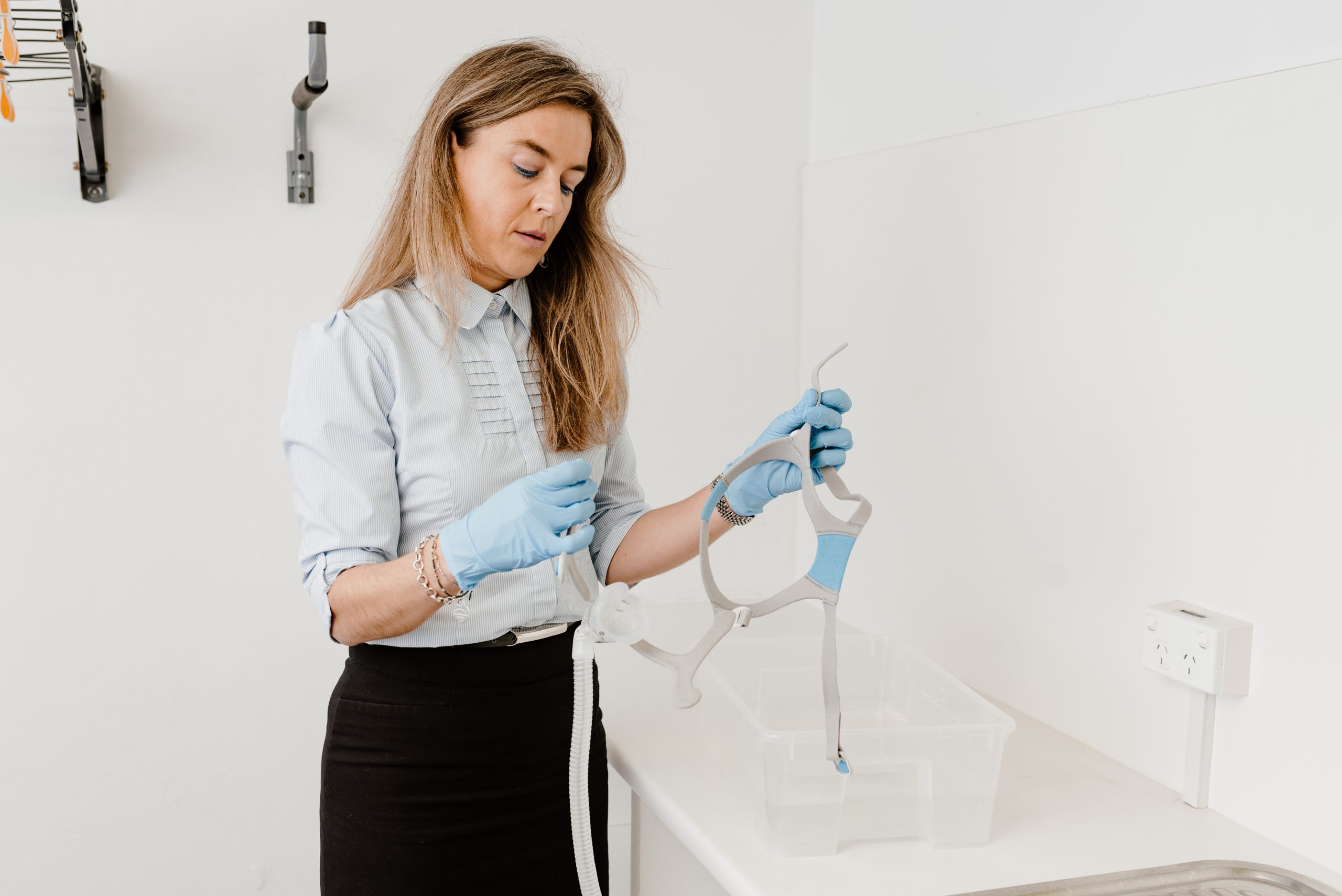
Step 8: Disassemble all mask parts.
-
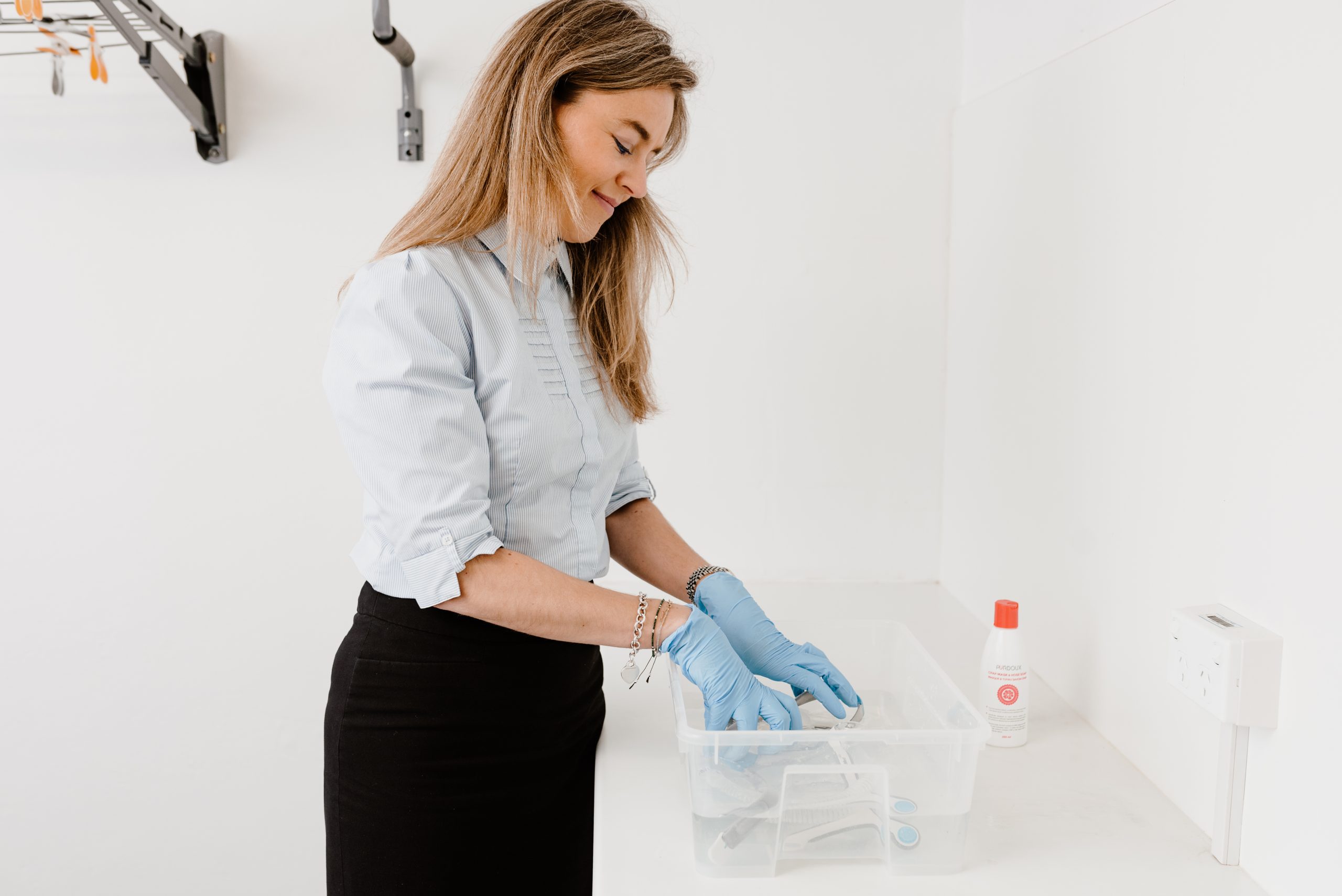
Step 9: Submerge all mask parts in water including headgear. Gently rub mask parts with hands to remove any oils.
-
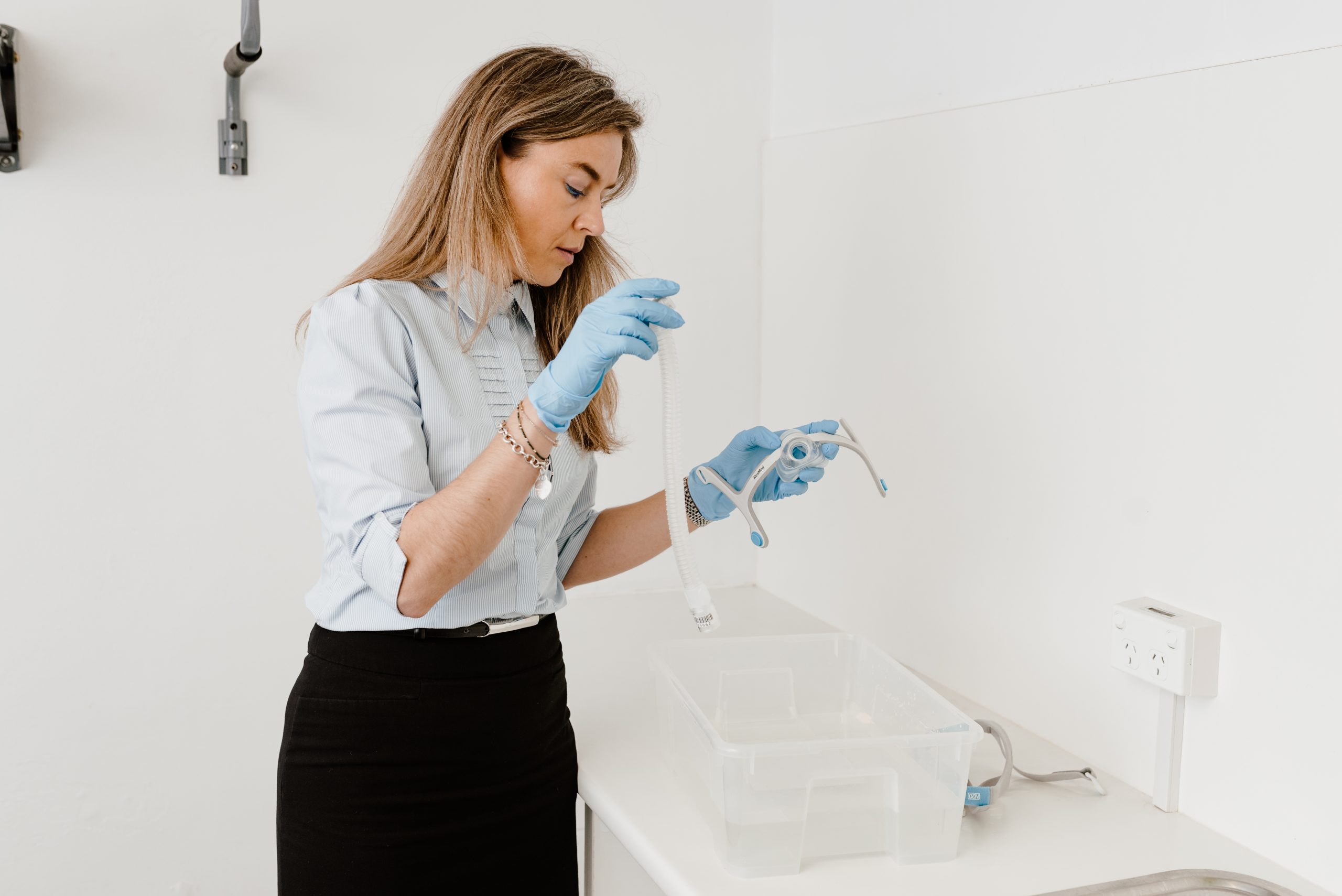
Step 10: Rinse all parts thoroughly then let air dry during the day on a flat surface. Headgear can be hung to dry quicker. Avoid direct sunlight.
-

Step 11: Your mask can be cleaned daily using mask wipes. Wipe cushion, frame and tubing (if applicable) then let air dry. Avoid direct sunlight.
Cleaning Your CPAP Tube
-
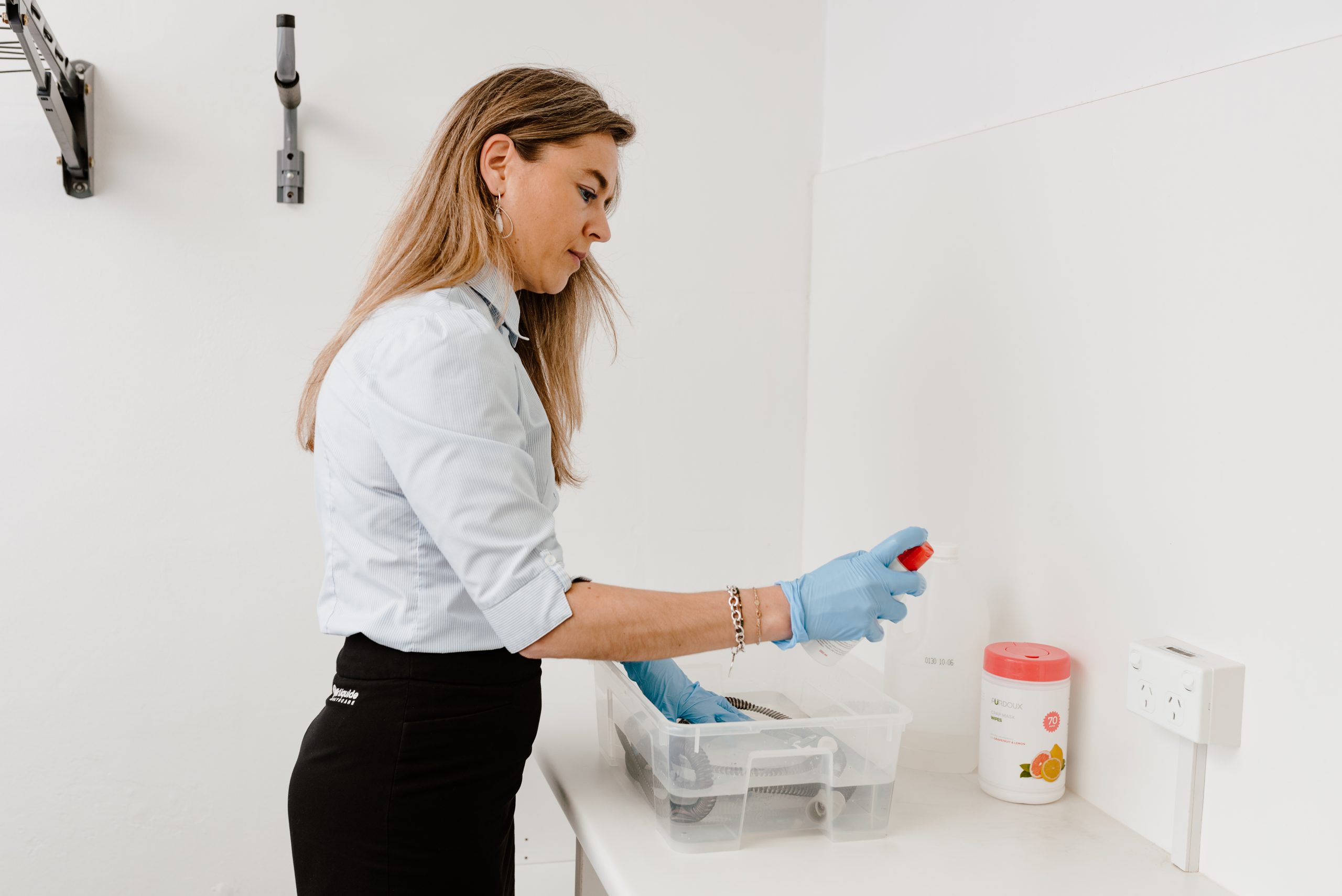
Step 13: Disconnect your air tubing from your
mask and PAP device. Fill a basin with warm soapy water. Avoid using strong cleaning products, including dish detergents, as they may damage the air tubing or leave harmful residue. -

Step 14: Submerge the air tubing in the warm soapy water allowing water to pass through the tubing.
-
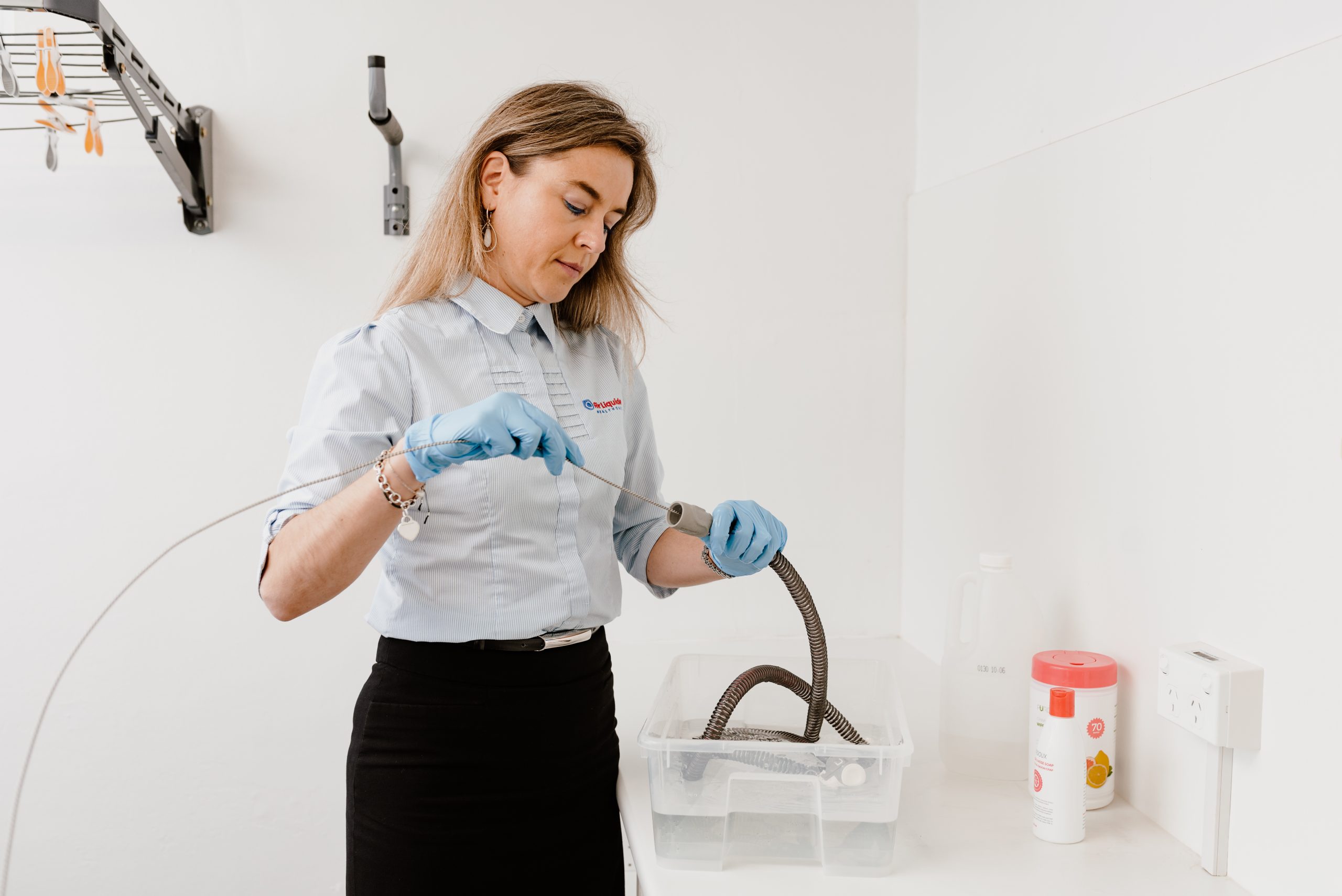
Step 15: Use a tubing brush to help scrub the inside of the air tubing.
-
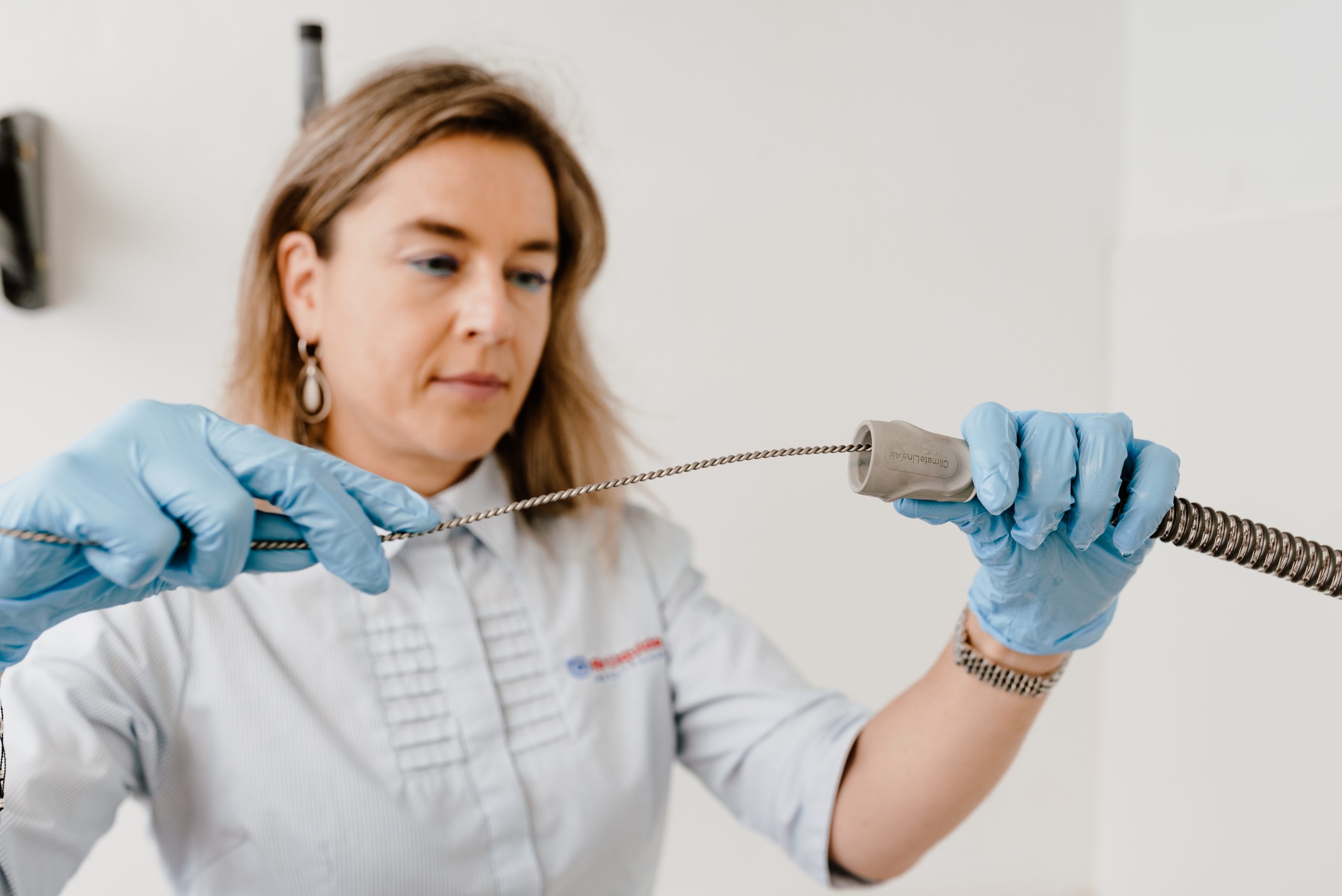
Step 16: Move the tubing brush forward and backward for effective cleaning.
-
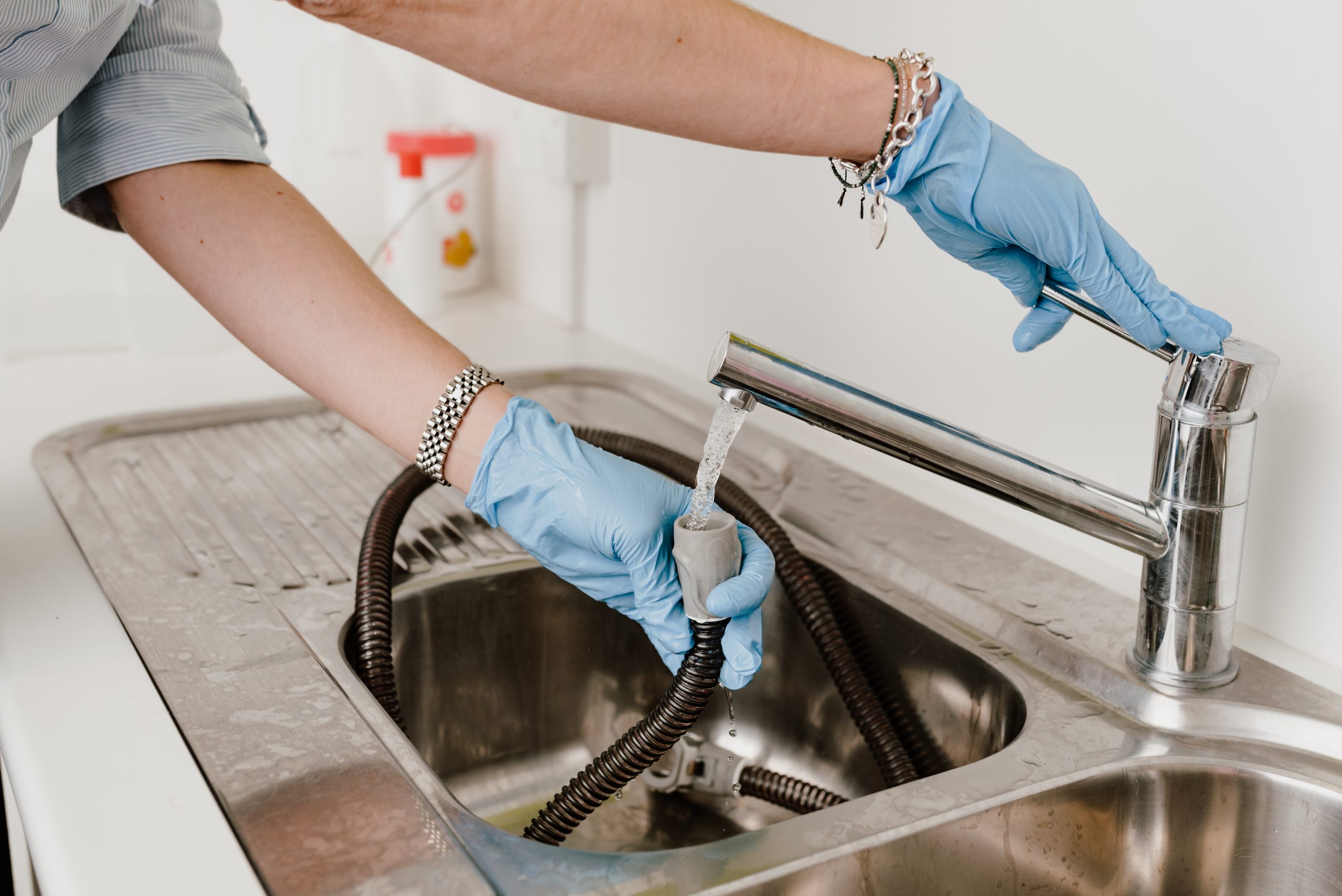
Step 17: Run warm water around and through the air tubing until all soap has been removed.
-
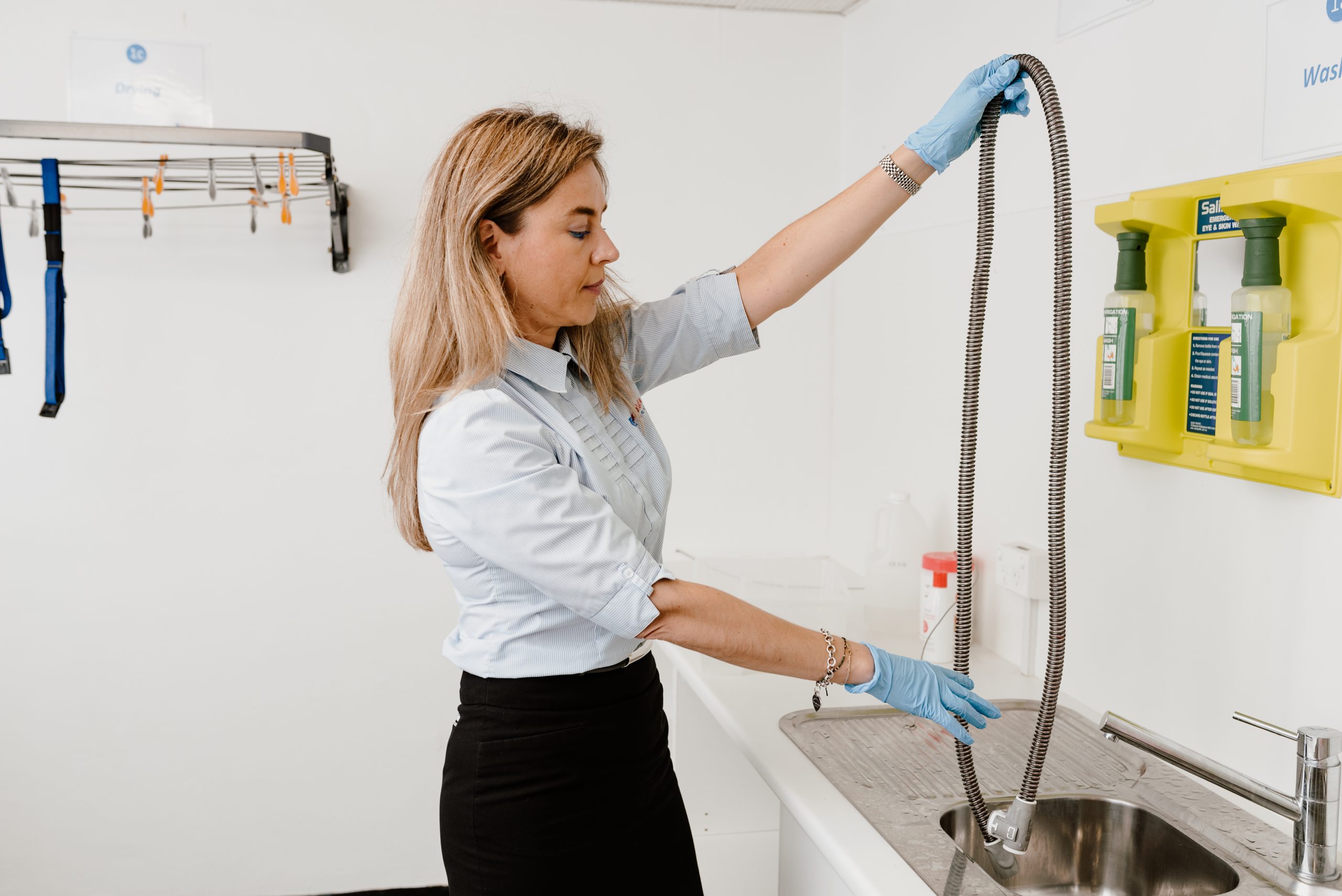
Step 18: Lift air tubing in a vertical motion to allow all water to escape from inside.
-

Step 19: Once dry, hang in an area out of direct sunlight. For quicker drying time, attach to your PAP device and turn on. The air flow dry the remaining water residue.
Travelling with PAP
-
Can I get a battery for my CPAP device?
Yes, some manufacturers supply batteries made specifically for their devices. These batteries are sealed Lithium ion batteries and are certified for use on planes. Speak to your Sleep Therapy Consultant to find out which battery is suitable for your CPAP device.
-
Do I have to pay excess luggage fees at the airport for my CPAP equipment?
Medical devices normally do not count towards your carry-on luggage limit, but it’s best to check with your airline for confirmation.
Note:
Clicking on the link below will transfer you to a third party website. The information on that website is not controlled by Air Liquide Healthcare.
https://www.resmed.com.au/knowledge-hub/will-my-CPAP-device-count-towards-my-carry-on-luggage-limit
-
Is there any CPAP device which has a built in battery?
No, only external batteries are available.
-
Can I use my CPAP device on an airplane or a cruise ship?
Yes. You’ll need to know what voltage you will be getting while on board. Consult with the airline or shipping line you are going with to find this out. Then talk with your ALH Clinic Representative or CPAP supplier to make sure that the CPAP will work at this voltage. As a rule, the airline will need a medical certificate from your doctor. They may also only let you use specific CPAP devices on board the flight. Getting all this ready can take some time. This means it is best to start planning well before your departure date.
Note: Clicking on the link below will transfer you to a third party website. The information on that website is not controlled by Air Liquide Healthcare.
https://www.sleephealthfoundation.org.au/travelling-with-CPAP.html
-
Are CPAP travel devices noisier?
Travel devices are slightly louder but not by much. The most common stationary CPAP devices have a sound power level of around 35 dBA. Travel CPAP devices (like the ResMed AirMini and the Philips DreamStation Go). typically have an increased sound power level of around 2 dBA.
-
Which is the best CPAP device for travel?
The ResMed AirMini and Philips DreamStation Go are both effective travel devices capable of providing the same therapy you would receive from a stationary CPAP device. If you normally use a humidifier and would like to have the same feature on your portable device, the DreamStation Go has a separate humidifier that can attach to it. This does not mean that other makes and models are not suitable for travel. You should check with your CPAP supplier to verify the suitability of the particular CPAP device you currently have or wish to purchase for travel.
-
What if my CPAP device stops working overseas, where do I go?
You can search for an Air Liquide Healthcare office or other CPAP provider near you. You will normally be able to be provided with the some level of support and assistance as you would receive in Australia.
-
Do I need a letter from my doctor for the airline?
Not all airlines require a letter from your doctor but we recommend obtaining one. If you plan to use your device while onboard, some airlines like Qantas require you to complete a clearance form prior to flying but do not require clearance from a medical practictioner.
Note: Clicking on the link below will transfer you to a third party website. The information on that website is not controlled by Air Liquide Healthcare.
https://www.qantas.com/au/en/travel-info/specific-needs/travelling-with-specific-needs/medical-equipment-and-medications-onboard.html
-
What extra equipment do I need in order to travel with my CPAP device?
Depending on the type of travel you are doing, you may require a battery, electrical adaptors, voltage converter and/or a DC inverter. Speak to your Sleep Therapy Consultant to find out which equipment is required for your travel.
-
Can I take my CPAP device as a carry on onboard a flight?
Yes, CPAP devices are accepted as carry on luggage.
-
Can I go a few days without using my device while I am travelling?
As soon as you stop using CPAP, your breathing during the night will get worse. This means your daytime symptoms will come back. Think back to how things were before you started CPAP. There is a risk of going back to feeling this way. You may suffer from morning headaches and feel tired and moody during the day. Everyone is different and the time is takes for onset of these symptoms will vary, but it is possible that these may come back after the first night with no CPAP. Feeling tired during the day is a potential problem. This will raise your risk of road and other accidents if you are driving on your holiday or travels. If you feel tired, do not drive as you and others will be at risk.
Note: Clicking on the link below will transfer you to a third party website. The information on that website is not controlled by Air Liquide Healthcare.
https://www.sleephealthfoundation.org.au/travelling-with-CPAP.html
-
Which CPAP devices are portable?
Air Liquide Healthcare offer 2 portable travel CPAP devices, the ResMed AirMini and the DreamStation Go.
-
How long will the battery last while using my CPAP device?
There are a few variables to factor in when determining how long your CPAP portable battery will last when using your device. The higher the CPAP pressure required, the more more battery power will be used. A large mask leak will also demand more battery power. If you are using a humidifier with water, the battery power will run out much sooner than without a humidifier. As an example, if you use a ResMed AirMini or Philips DreamStation Go with the recommended manufacturer portable battery on a CPAP of 10cmH2O with no humidification, the battery life is estimated at 13 hours. These batteries are sealed Lithium ion batteries and are certified for use on planes. Speak to your Sleep Therapy Consultant to find out which battery is suitable for your CPAP device.
-
Can the batteries be purchased at a clinic?
Yes, you can purchase portable CPAP batteries at our clinics.
-
Will my CPAP device adjust for pressure changes in altitude?
Most CPAP devices will automatically compensate for changes in altitude. Some older devices might require manual adjustment though. If no adjustment is made to these, it may deliver less effective therapy. Speak to your Sleep Therapy Consultant to find out if your device automatically compensates for changes in altitude. Alternatively, you can refer to the device User Manual where this information may be found.
Alternative Therapy
-
Is a Mandibular Advancement Splint (MAS) as effective as a CPAP device?
No, it is not. A MAS may be used and may be an option as an alternative to CPAP therapy depending on the severity of the sleep apnea, a persons tolerance to a CPAP device and many other personal and medical circumstances. According to the Royal Australian College of General Practitioners, people likely to gain the most benefit from MADs include: those with mild-to moderate sleep apnea, young people, people with sleep apnea that improves when sleeping on their side, females, those with a receding jaw, structure (also known as a retrognathic mandible). The following people are less likely to see symptom improvement with MADs: older adults individuals with obesity and those with excess fat tissue around the neck, those with a stiff jaw, which makes advancement difficult, people with dental, conditions, such as gum disease, people with central sleep apnea, which is a neurological condition rather than a mechanical one. Speak to your Sleep Therapy Consultant and Sleep Physician to determine which one is suitable for you.
Note: Clicking on the link below will transfer you to a third party website. The information on that website is not controlled by Air Liquide Healthcare.
-
What’s that little CPAP pump device all about?
To date, micro-CPAP devices aren’t included on the Australian Register of Therpeutig Goods (ARTG). We only offer equipment that is included on the ARTG and has been clinically proven to provide effective treatment for OSA.
Is a Mandibular Advancement Splint (MAS) as effective as a CPAP device?What’s that little CPAP pump device all about?
To date, micro-CPAP devices aren’t included on the Australian Register of Therpeutig Goods (ARTG). We only offer equipment that is included on the ARTG and has been clinically proven to provide effective treatment for OSA.Note: Clicking on the link below will transfer you to a third party website. The information on that website is not controlled by Air Liquide Healthcare.
-
How do I know my MAS is working?
You can compare your symptoms before and after treatment to determine its effectiveness. Alternatively you can do a home based sleep study while using the device. Depending on your situation, you may or may not receive a Medicare rebate for the sleep study.
-
Are mouthguards (MAS) covered by medicare or private health?
No, Medicare do not cover MASs. Depending on your private health insurance, a small portion of the cost may be covered. We recommend checking with your private health insurer as part of considering this option together with your health professional.
-
How long does a splint last?
We offer 2 MAS devices, the Oniris which is a boil and bite MAS and the Oventus which is a custom fitted MAS. Both come with a 12 month warranty (on the device and not the success of the therapy). The longevity of the devices depend on the usage, cleanliness and if the patient grinds their teeth.
-
If I lose weight will I still need a CPAP device or any alternative therapies?
Weight loss may decrease the severity of your sleep apnea but we recommend you do a home sleep study to verify wheather your diagnosis for OSA has changed. This shall be done in conjunction with a healthcare professional.
-
Do you sell pillows instead of CPAP therapy?
We do not offer sleeping pillows and do not recommend using a pilllow to treat sleep apnea.
-
Why can I not start with the alternate therepy first?
CPAP is more effective overall than MASs for treating sleep apnea. For this reason we start all our patients on CPAP therapy first. We recommend consulting with a healthcare professional to determine if an alternatove therpy may be a suitable option for you. ALH respects and follows all health professional prescriptions for OSA.
Note: Clicking on the link below will transfer you to a third party website. The information on that website is not controlled by Air Liquide Healthcare.
https://www.medicalnewstoday.com/articles/mandibular-advancement-device#mad-vs-CPAP
-
What are the alternatives to a CPAP device?
Once a diagnosis of OSA is established, ALH recommends talking with your doctor about the need for treatment and the options available for you. The circumstances often vary from person to person, since the underlying causes may be different. Generally speaking, the options can include one or more of the following:
Weight loss – For anyone who is overweight, losing weight is recommended. While this may not necessarily cure the OSA, it usually improves snoring and OSA symptoms, and can help other treatments work more effectively. It also provides general health benefits.
Reduce alcohol consumption – Alcohol usually worsens snoring and OSA due to the throat muscles relaxing. For some people drinking alcohol makes their OSA worse. If this is the case for you then less or no alcohol may be a useful treatment.
Body position during sleep – Snoring and OSA are usually worse when lying on the back. This is because of the effects of gravity on the tongue. Avoiding sleep in this position can improve OSA. In some people it can completely control the problem. This is best achieved by wearing a device that makes it uncomfortable to sleep on your back. Some such devices can be purchased or it can be as simple as sleeping with a tennis ball sewn into a pocket on the back of your pyjamas.
Managing blocked nose – A blocked nose causes mouth breathing, which can lead to snoring and OSA. The blocked nose can be due to different problems, such as allergies, sinus disease, and a deviated septum. Your doctor can assess and provide treatment, depending on the problem. This may involve the use of nasal sprays to relieve congestion. Sometimes surgery is required to correct anatomical problems.
CPAP (Continuous Positive Airways Pressure) – This is generally considered to be the most effective way to treat OSA. It involves the use of a special device during sleep, connected to a nose or face mask via tubing. The device gently increases air pressure in your throat holding it open, thus preventing snoring and OSA. See our CPAP link.
Oral Appliances – These are specially made dental plates that are worn during sleep. They push your lower jaw forwards so that your throat opens up, reducing the risk that it will vibrate (snore) or obstruct. The appliances have various names such as Mandibular Advancement Splints (MAS) or Mandibular Advancement Devices (MAD) or Mandibular Repositioning Appliances (MRA). Your suitability for this form of treatment is best discussed with your sleep physician, who will then refer you to a trained dentist. See our Oral Appliances link.
Surgery – Surgery may help in cases of OSA caused by a discrete blockage of some part of the nose or throat. There are many types of operations depending on where in your nose and/or throat the problem lies. The decision about whether surgery is right for you may require the expert input of an ENT surgeon. The risks and benefits need to be weighed up in each case. In adults, surgery is often the last resort, after other treatments have been tried first. Nasal surgery may be useful to help CPAP treatment by allowing nasal masks once the nasal blockage is repaired. In children with OSA, surgery to remove tonsils and adenoids is quite commonly done and is often very helpful.
Note: Clicking on the link below will transfer you to a third party website. The information on that website is not controlled by Air Liquide Healthcare.
https://www.sleephealthfoundation.org.au/treatment-options-for-obstructive-sleep-apnea-osa.html
-
How do I adjust the MAS device?
Each MAS is supplied with a set of advancements straps which attach to the sides of the device. In general, as you get more comfortable, change the advancement strap to the next size up in order to advance your lower jaw forward and relieve the obsruction in your airway. Continue increasing the size of the advancement straps until your snoring is relieved, this may take days or weeks depending on the severity of your sleep apnea. It is recommended you refer to the User Manual supplied with your specific MAS devive for precise instructions on its safe use.
Note: Clicking on the link below will transfer you to a third party website. The information on that website is not controlled by Air Liquide Healthcare.
-
Can I trial these alternative therapy options?
No, we do not trial MASs for hygienic reasons and the fact that they are customised for you and molded to your teeth.
-
Will surgery help me with my obstructive sleep apnea?
Surgery may help in cases of OSA caused by a discrete blockage or narrowing of some part of the air passages in the nose or throat. There are many types of operations depending on where in your nose and/or throat the problem lies. The decision about whether surgery is right for you may require the expert input of an ENT surgeon. The risks and benefits need to be weighed up in each case. In adults, surgery is often the last resort, after other treatments have been tried first.
Note: Clicking on the link below will transfer you to a third party website. The information on that website is not controlled by Air Liquide Healthcare.
https://www.sleephealthfoundation.org.au/treatment-options-for-obstructive-sleep-apnea-osa.html
Diagnostics
-
How much will a sleep study cost me?
The sleep study is entirely covered by Medicare if the pretest questionnaire requirements are met.
Your sleep study appointment fee can vary. Air Liquide Healthcare clinics charge $49 and this fee is not covered by Medicare. We kindly request 48 hours notice if you need to reschedule your appointment.
-
How will the diagnosis of sleep apnea affect my driving license?
A conditional licence may be considered by the driver licensing authority subject to periodic review. Taking into account the nature of the driving task and information provided by the treating doctor as to whether the following criteria are met: the person is compliant with treatment and the response to treatment is satisfactory. Patients should be made aware of the effects of their condition on driving and should be advised of their legal obligation to notify the driver licensing authority where driving is likely to be affected. The health professional may themselves advise the driver licensing authority as the situation requires. The responsibility for issuing, renewing, suspending or cancelling, or reinstating a person’s driver licence (including a conditional licence) lies ultimately with the driver licensing authority.
-
What happens if a lead falls off during the night?
You may be required to redo the study depending on the quality of data before the lead fell off, and the amount of time that the lead was off.
-
Can I drink alcohol while doing the home based sleep study?
Your alcohol consumption behaviour should not change. The purpose of the home based sleep study is to collect data as close to normal as possible. Alcohol affects nighttime breathing and it is best for us to be able to measure your sleep in its most vulnerable state to determine how it is disturbed. Be mindful that you should not drink and drive to retrieve the equipment at any of our clinics.
-
How do I start and stop the sleep test?
Run the Somfit®App.
From the Somfit App Home screen, press the ‘Start Study’ button to start a new study.
After Somfit completes pre-checks, the recording screen will appear.
Do not open other Apps and avoid using your phone after you start the study.
You can lock the phone screen, but do not put the phone in aeroplane mode.
Ensure phone is charging on your bedside table.
When you wake simply, press the ‘END STUDY’ button.
Confirm you wish to the end study by clicking ‘Yes’.
Data upload will automatically occur.
-
Does the sleep study device make a noise?
No. The sleep study device is silent.
-
Can I sleep on my side?
Yes, you can sleep on your left, right, front and back. Our goal is to collect the best data we can about you while you sleep. To do this, we will want to see you sleep in your usual positions.
-
Is cleaning the site that important?
Cleaning is a crucial step in preparing the skin site for the electrode pad. If the skin site is not prepared well, the signal may be weak or not seen at all and result in an incomplete study. The sleep study will have to be redone if our sleep study team cannot accurately measure the signals coming from all parts of your body.
-
How accurate are the sleep study results, I hardly slept at all?
Home sleep studies are very accurate because the sleep study device measures various biometric data points which are then sent to our team of independant Sleep Physicians to analyse. Even if you sleep for only a few hours we will be able to gather a sufficient amount of information. It only takes a few hours of sleep for a breathing disturbance such as apnea to be detected, even with less restful sleep.
-
What is the cost of the test, and why is it different at different clinics?
As of 1 Nov 2018, any patient wishing to have a home sleep study done will need to complete a series of questionnaires with their physician. The scores of those questionnaires will determine if Medicare will fund the study or not. If the study is not Medicare funded the patient can choose to pay for the sleep study privately.
-
What does the flashing light on my sleep study device mean? Did my study stop working?
A single green light blinking every 10 seconds means your device is ready to record.
It is normal for the indicator light on both the Somfit® and Respifit® to be turned off during recording.
-
Do I need to see a Sleep & Respiratory Specialist to get a referral for a sleep study?
SNo you don’t. Your General Practitioner can refer you for a sleep study. You can complete our online referral form here then take it to your GP.
-
How long do I have to wear the sleep study device?
Once set up for the study, a minimum of 9 hours wearing time is recommended. This is to obtain as much data as possible and to fullfill Medicare requirements. You do not need to be asleep for the 9 hours, but you do need to be wearing the device with everything attached to your body for this period of time.
-
Do I have to be asleep for the whole recording duration?
No, a full night’s sleep isn’t required to obtain accurate sleep study results. It only takes a few hours of sleep for a breathing disturbance such as apnea to be detected, even with less restful sleep.
-
Is there a number I can call if I get stuck?
You can call our Customer Contact Centre on 1300 36 02 02 to speak to one of Customer Service Representatives during operating hours Mon – Fri 9:00am – 5:00pm (AEST). Alternatively, you can utilise the instructional videos on our website, or call the clinic that you collected the home based sleep study kit from for assistance.
-
Can I have my sleep study in a hospital?
According to Medicare Item 12203, in order to complete a sleep study in a lab, you must be assessed by a qualified sleep medicine practitioner or consultant respiratory physician to determine why a lab study is required over a home sleep study.3
-
What does a home based sleep study measure?
Our home sleep study measures; total sleep time, sleep latency, sleep stages, arousals, snoring, body position, heart rate, blood oxygen saturation, apnea hypopnea index and breathing patterns. These results will give us an indication of how many times per hour your airway is restricted throughout the night, and a measure of how severe these events were when they occur.
-
How many nights do I have to sleep with the device?
You are only required to use wear the sleep study device for 1 night and return it the following morning. Please note that if you are doing the study over a weekend you must wear the device for the night that you have been instructed to do so. The device has been programmed to record for one night only, and if you wear it on a different night from that instructed, the study will fail.
-
What are some tips to ensure leads don’t come off during the night?
If you intend on taking a shower on the night of your sleep study, make sure you do so at least one hour before you apply the equipment so your skin has enough time to dry thoroughly. Do not apply lotion or oils to the skin where the electrodes are to be attached. Make sure the location where you apply the electrode is cleaned well with the alcohol wipe and prep pad provided.
-
When am I going to receive the results of my sleep study?
You should receive your sleep study report about 3 – 4 weeks after returning your device. In some instances this may be longer due to unforseen circumstances but we will communicate if a different timeline may be expected.
-
Do I have to see a sleep physician afterwards?
Our independant Sleep Physicians will provide a non biased sleep report which includes a diagnosis and recommendation. A consultation with a Sleep Physician may be included in the report as a recommendation. Even if this is not a recommendation in your sleep report, you are welcome to seek further advice from your General Practicitioner or Sleep Physician.
-

Pap Devices
Find the latest updates about the mask devices

To enhance the quality of life for all patients through providing compassionate care and extraordinary service



